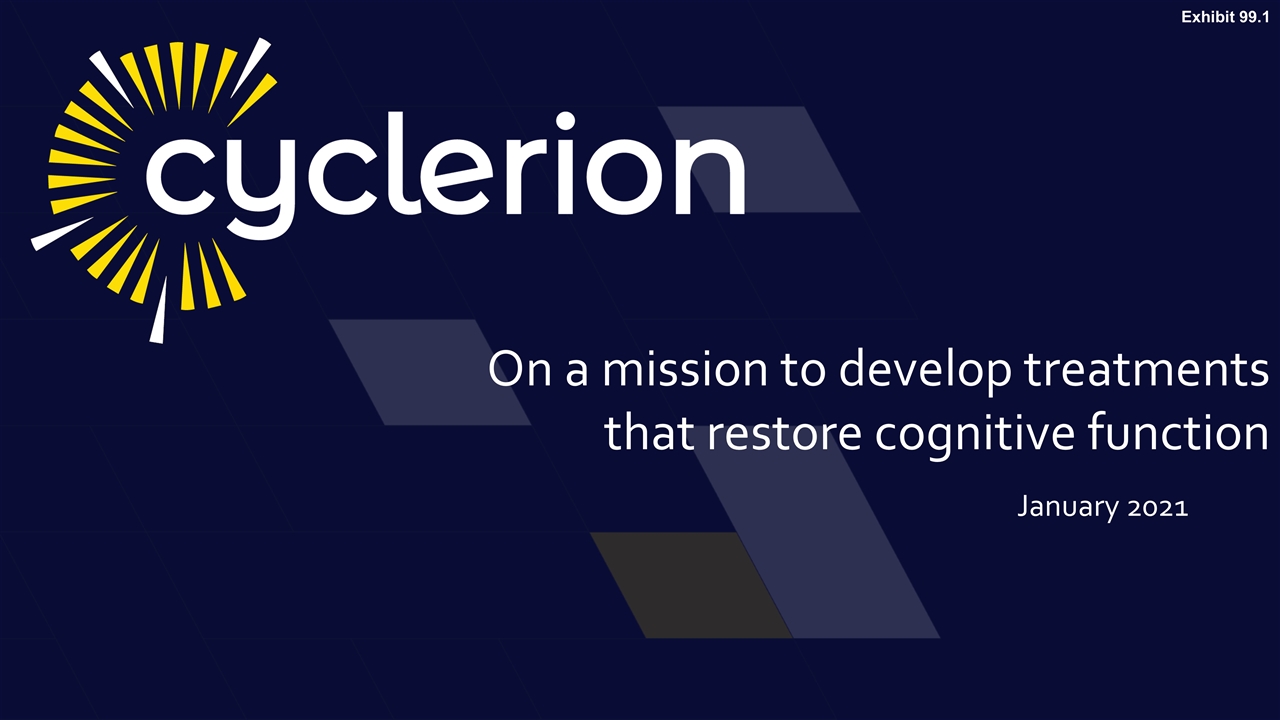
January 2021 On a mission to develop treatments that restore cognitive function Exhibit 99.1
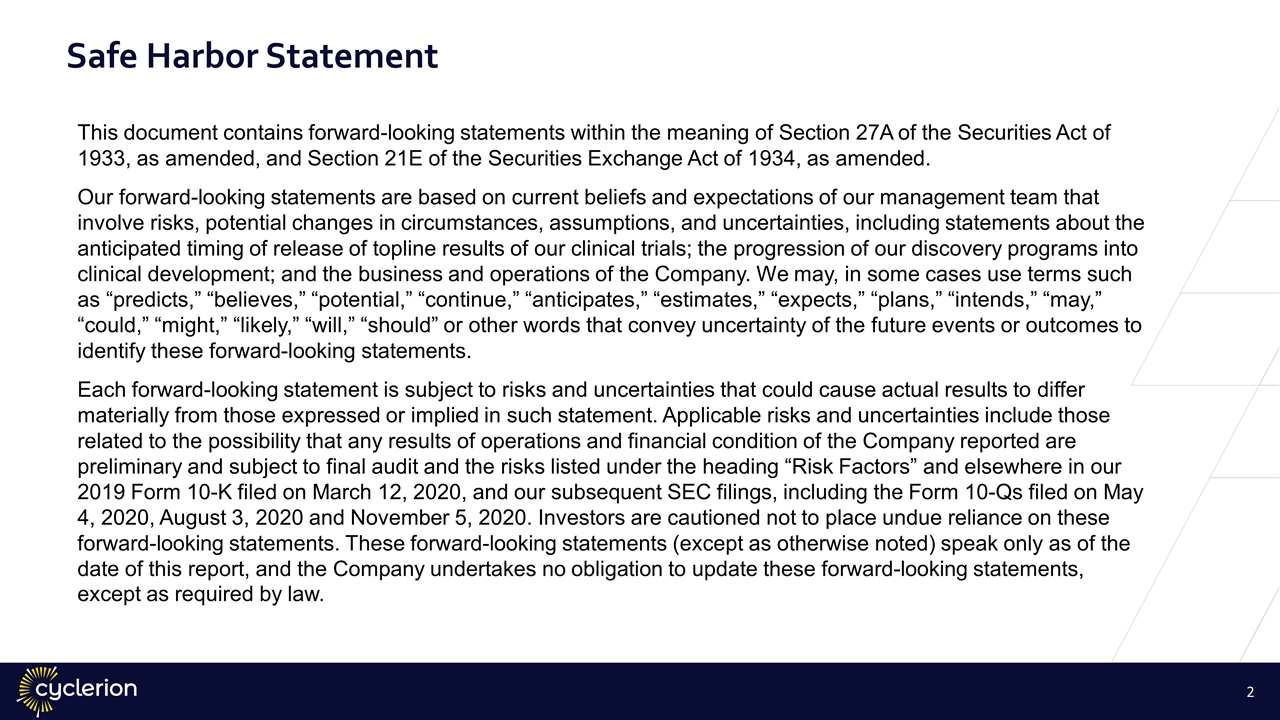
This document contains forward-looking statements within the meaning of Section 27A of the Securities Act of 1933, as amended, and Section 21E of the Securities Exchange Act of 1934, as amended. Our forward-looking statements are based on current beliefs and expectations of our management team that involve risks, potential changes in circumstances, assumptions, and uncertainties, including statements about the anticipated timing of release of topline results of our clinical trials; the progression of our discovery programs into clinical development; and the business and operations of the Company. We may, in some cases use terms such as “predicts,” “believes,” “potential,” “continue,” “anticipates,” “estimates,” “expects,” “plans,” “intends,” “may,” “could,” “might,” “likely,” “will,” “should” or other words that convey uncertainty of the future events or outcomes to identify these forward-looking statements. Each forward-looking statement is subject to risks and uncertainties that could cause actual results to differ materially from those expressed or implied in such statement. Applicable risks and uncertainties include those related to the possibility that any results of operations and financial condition of the Company reported are preliminary and subject to final audit and the risks listed under the heading “Risk Factors” and elsewhere in our 2019 Form 10-K filed on March 12, 2020, and our subsequent SEC filings, including the Form 10-Qs filed on May 4, 2020, August 3, 2020 and November 5, 2020. Investors are cautioned not to place undue reliance on these forward-looking statements. These forward-looking statements (except as otherwise noted) speak only as of the date of this report, and the Company undertakes no obligation to update these forward-looking statements, except as required by law. Safe Harbor Statement
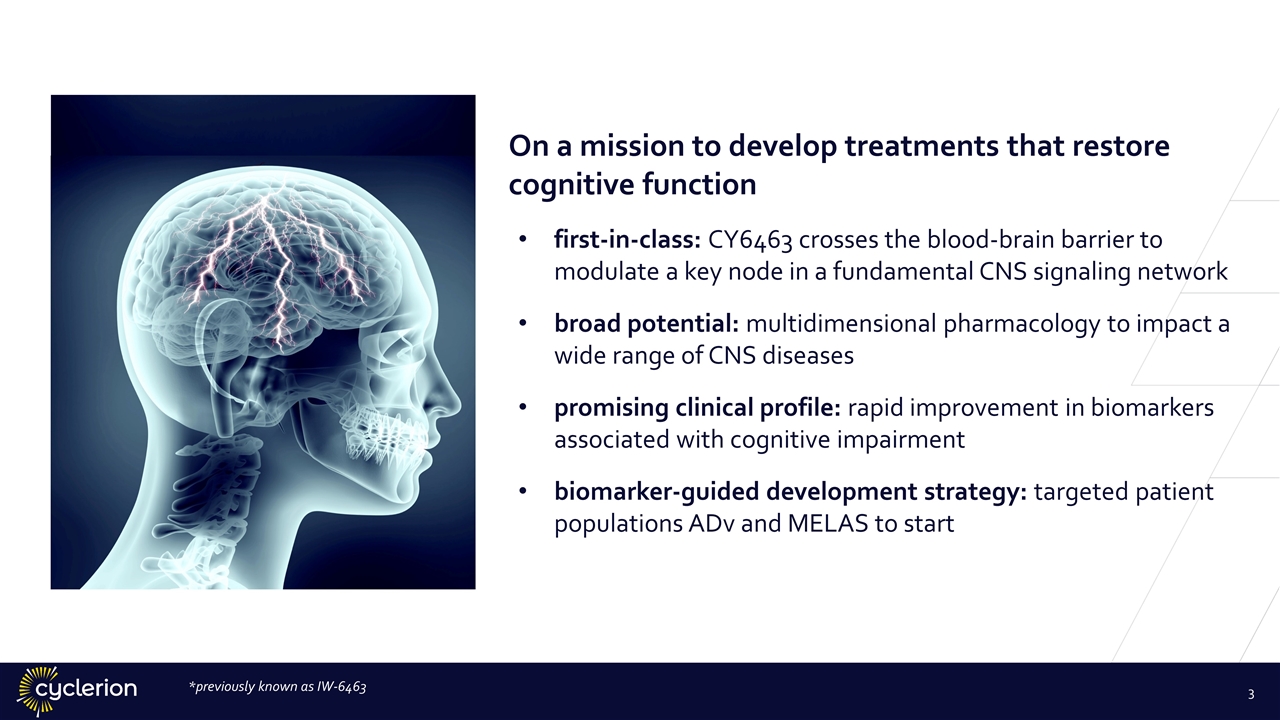
On a mission to develop treatments that restore cognitive function first-in-class: CY6463 crosses the blood-brain barrier to modulate a key node in a fundamental CNS signaling network broad potential: multidimensional pharmacology to impact a wide range of CNS diseases promising clinical profile: rapid improvement in biomarkers associated with cognitive impairment biomarker-guided development strategy: targeted patient populations ADv and MELAS to start *previously known as IW-6463
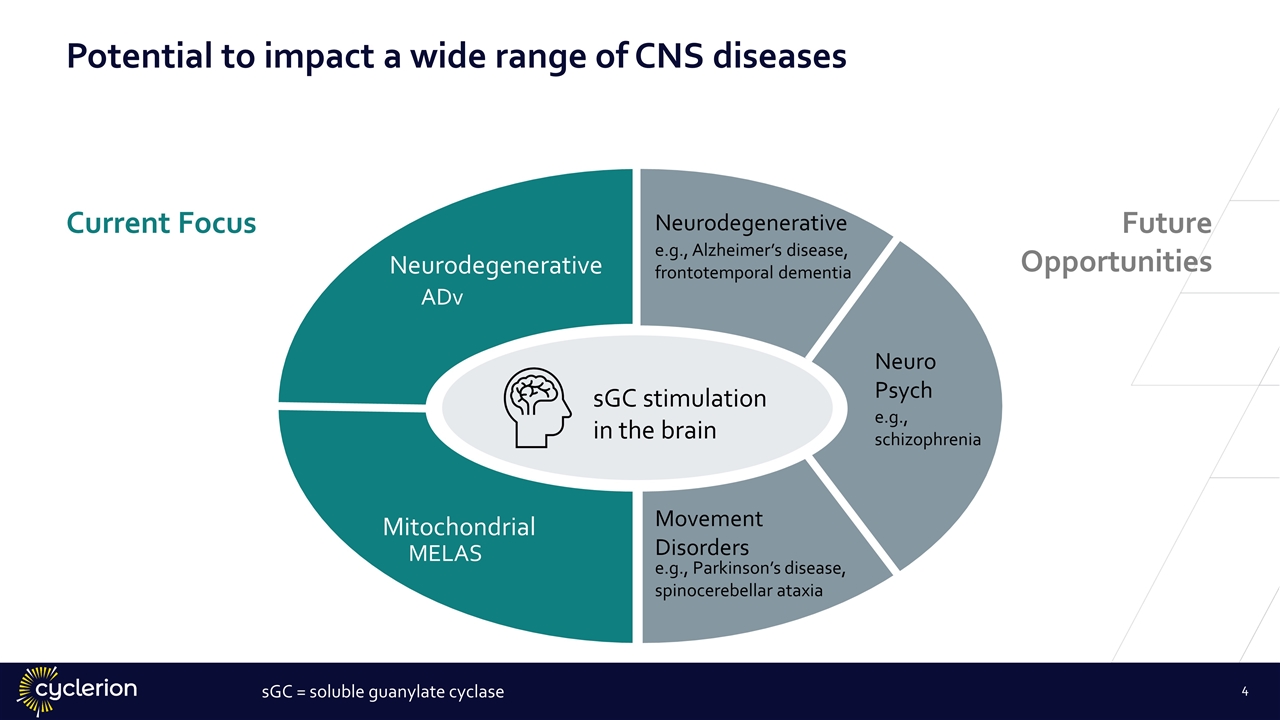
Potential to impact a wide range of CNS diseases Current Focus Future Opportunities Neurodegenerative ADv Mitochondrial MELAS Neurodegenerative e.g., Alzheimer’s disease, frontotemporal dementia Neuro Psych e.g., schizophrenia Movement Disorders e.g., Parkinson’s disease, spinocerebellar ataxia sGC stimulation in the brain sGC = soluble guanylate cyclase
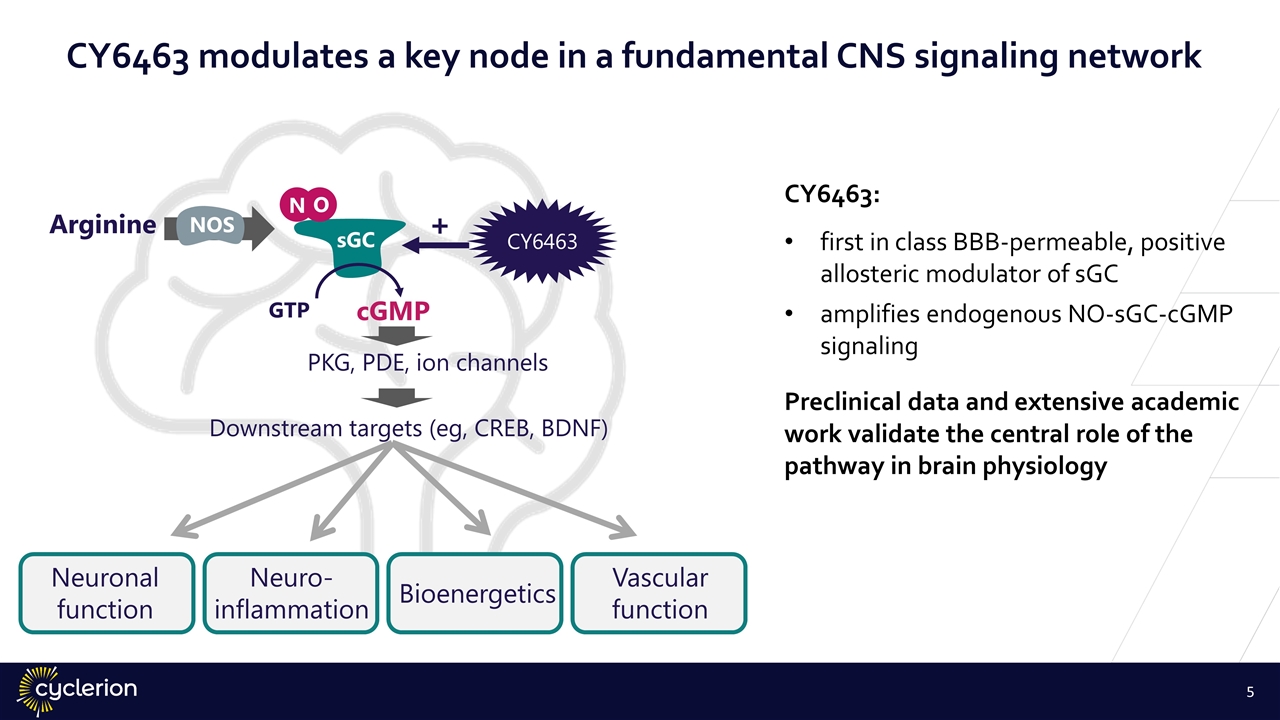
sGC GTP cGMP N O Arginine NOS PKG, PDE, ion channels + CY6463 Neuronal function Bioenergetics Vascular function Downstream targets (eg, CREB, BDNF) CY6463: first in class BBB-permeable, positive allosteric modulator of sGC amplifies endogenous NO-sGC-cGMP signaling Preclinical data and extensive academic work validate the central role of the pathway in brain physiology CY6463 modulates a key node in a fundamental CNS signaling network Neuro-inflammation
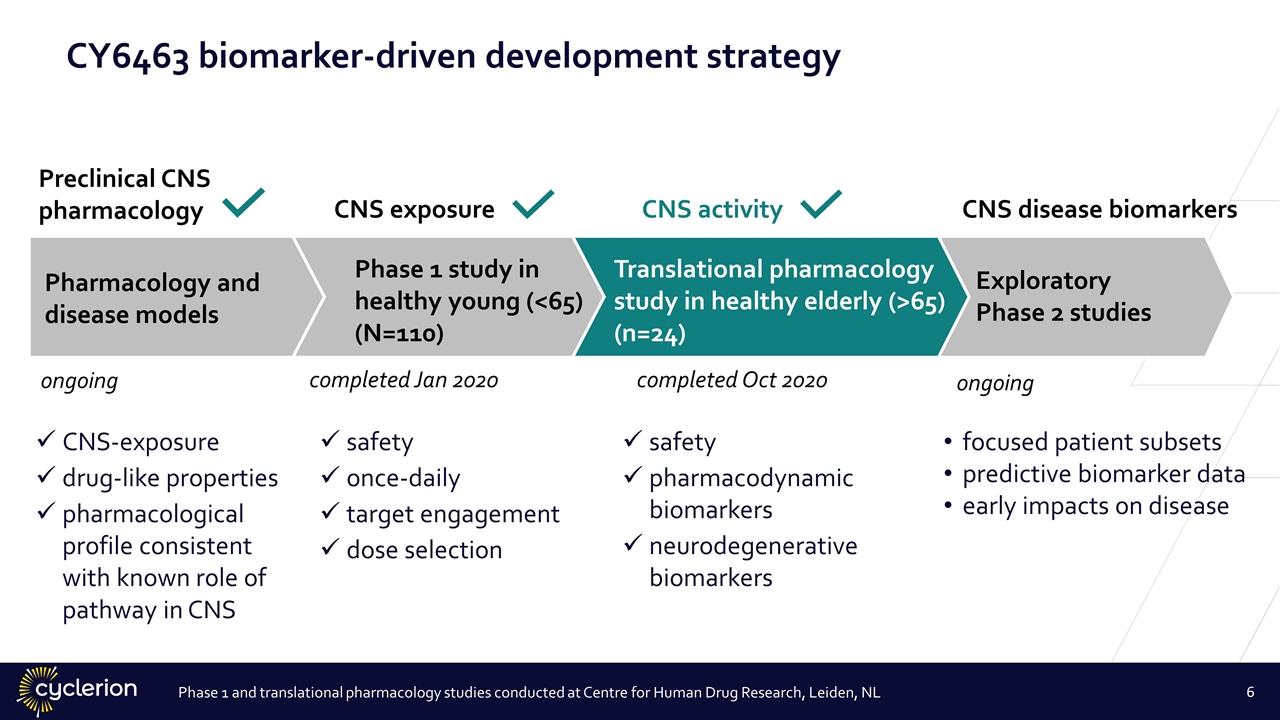
Translational pharmacology study in healthy elderly (>65) (n=24) Exploratory Phase 2 studies CNS exposure CNS activity CNS disease biomarkers Phase 1 and translational pharmacology studies conducted at Centre for Human Drug Research, Leiden, NL CY6463 biomarker-driven development strategy completed Jan 2020 safety once-daily target engagement dose selection completed Oct 2020 safety pharmacodynamic biomarkers neurodegenerative biomarkers focused patient subsets predictive biomarker data early impacts on disease Phase 1 study in healthy young (<65) (N=110) Pharmacology and disease models CNS-exposure drug-like properties pharmacological profile consistent with known role of pathway in CNS Preclinical CNS pharmacology ongoing ongoing
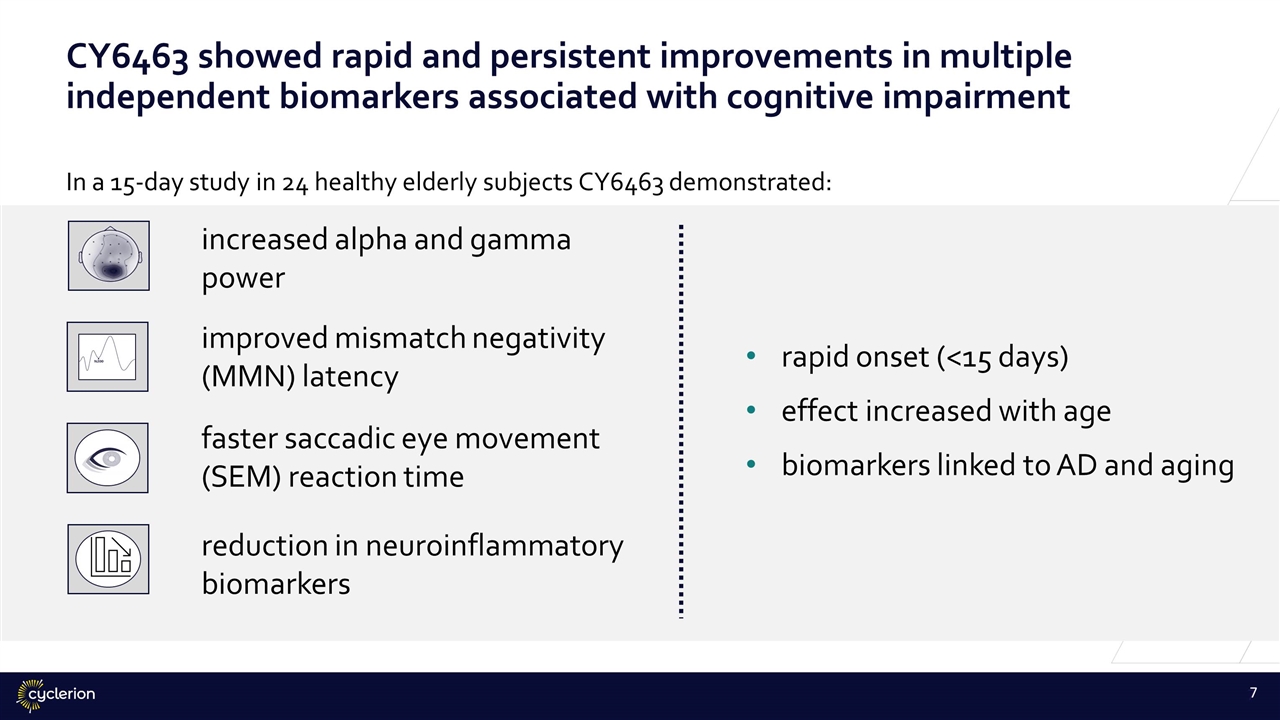
CY6463 showed rapid and persistent improvements in multiple independent biomarkers associated with cognitive impairment Neuronal Function increased alpha and gamma power improved mismatch negativity (MMN) latency faster saccadic eye movement (SEM) reaction time rapid onset (<15 days) effect increased with age biomarkers linked to AD and aging reduction in neuroinflammatory biomarkers In a 15-day study in 24 healthy elderly subjects CY6463 demonstrated:
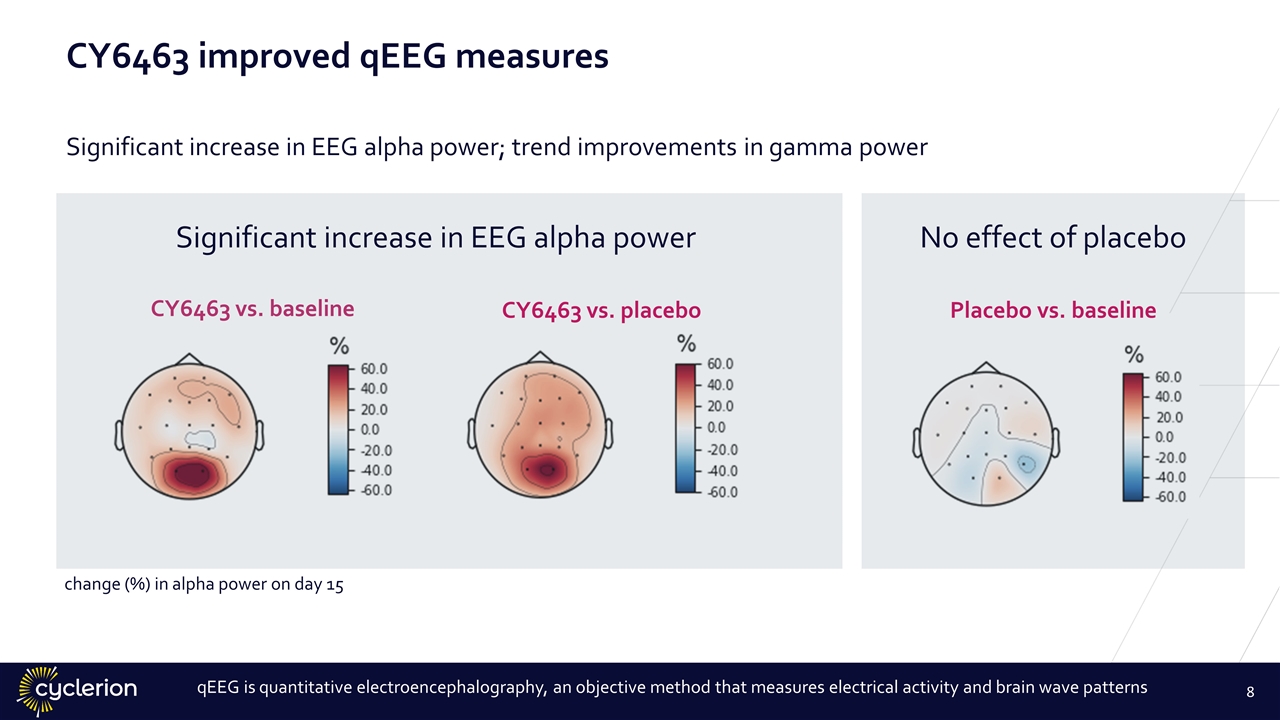
CY6463 vs. baseline CY6463 improved qEEG measures Significant increase in EEG alpha power No effect of placebo Placebo vs. baseline CY6463 vs. placebo qEEG is quantitative electroencephalography, an objective method that measures electrical activity and brain wave patterns Significant increase in EEG alpha power; trend improvements in gamma power change (%) in alpha power on day 15
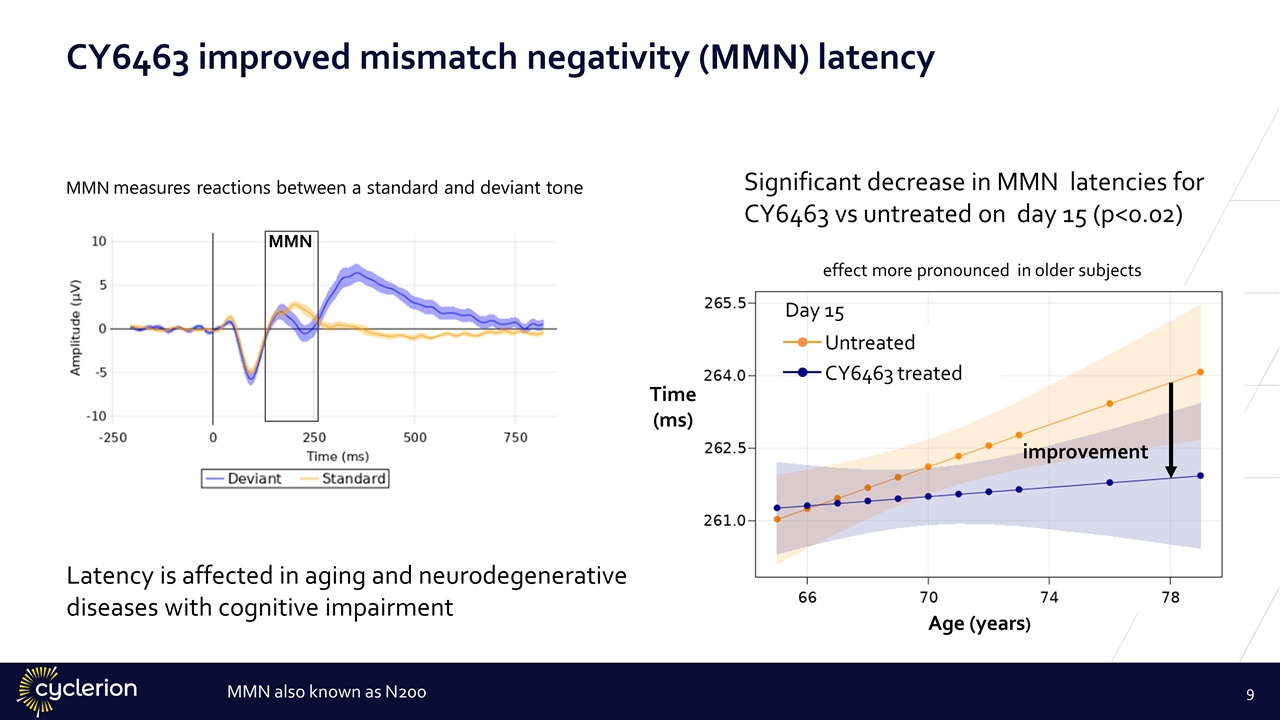
CY6463 improved mismatch negativity (MMN) latency MMN MMN also known as N200 Latency is affected in aging and neurodegenerative diseases with cognitive impairment MMN measures reactions between a standard and deviant tone Significant decrease in MMN latencies for CY6463 vs untreated on day 15 (p<0.02) improvement Age (years) Untreated CY6463 treated Time (ms) Day 15 effect more pronounced in older subjects
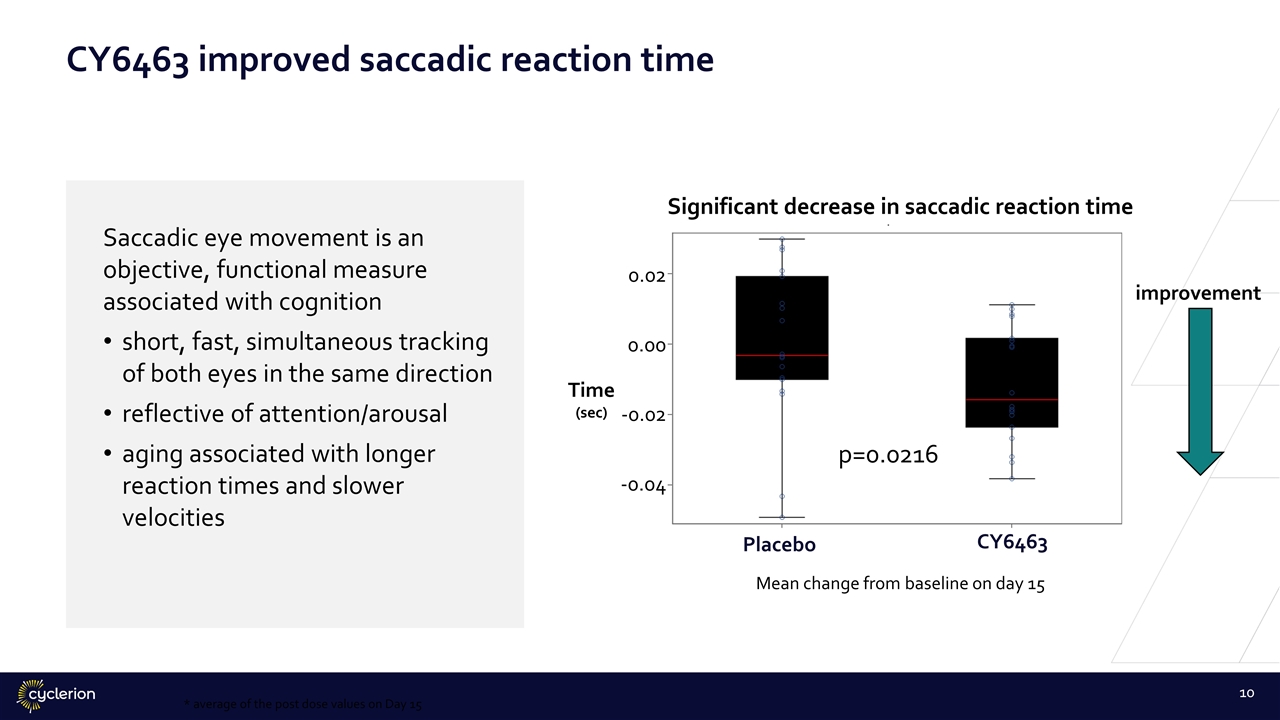
CY6463 improved saccadic reaction time * average of the post dose values on Day 15 0.02 0.00 -0.02 -0.04 Time (sec) p=0.0216 Significant decrease in saccadic reaction time Placebo CY6463 p=0.0216 Mean change from baseline on day 15 improvement Saccadic eye movement is an objective, functional measure associated with cognition short, fast, simultaneous tracking of both eyes in the same direction reflective of attention/arousal aging associated with longer reaction times and slower velocities
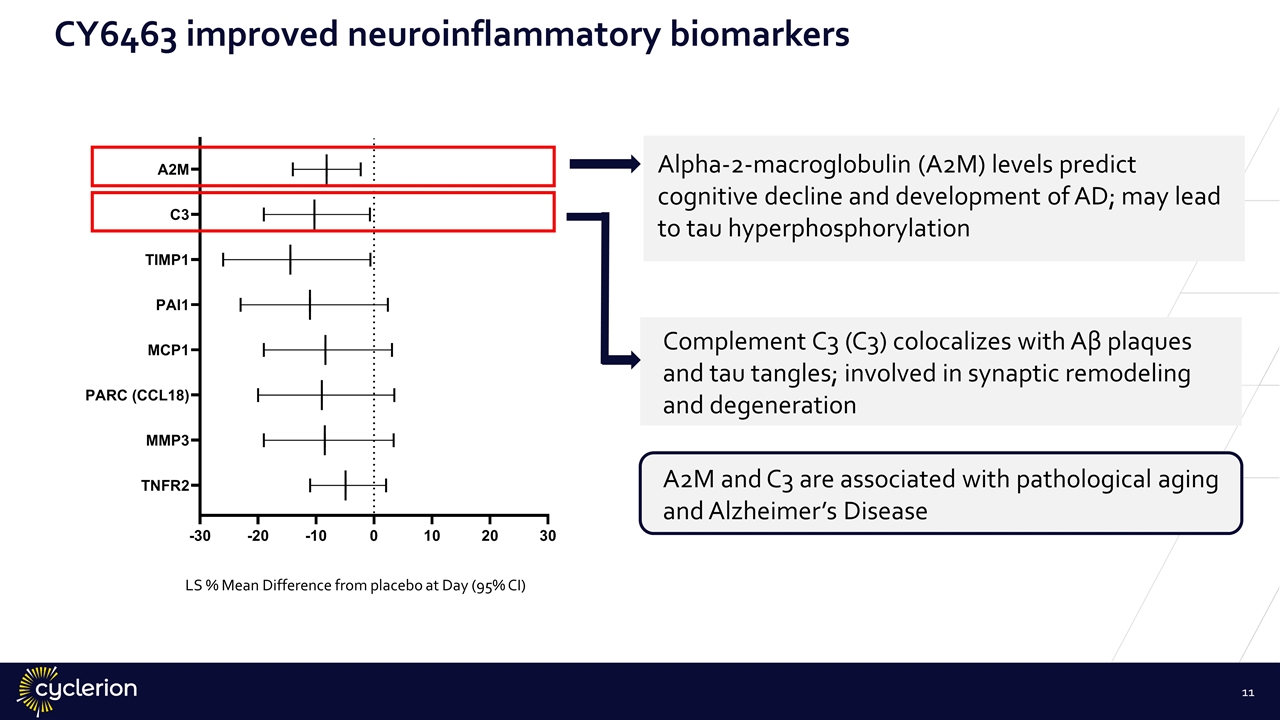
CY6463 improved neuroinflammatory biomarkers A2M and C3 are associated with pathological aging and Alzheimer’s Disease Difference from placebo at Day 15 LS % Mean Difference from placebo at Day (95% CI) Alpha-2-macroglobulin (A2M) levels predict cognitive decline and development of AD; may lead to tau hyperphosphorylation Complement C3 (C3) colocalizes with Aβ plaques and tau tangles; involved in synaptic remodeling and degeneration
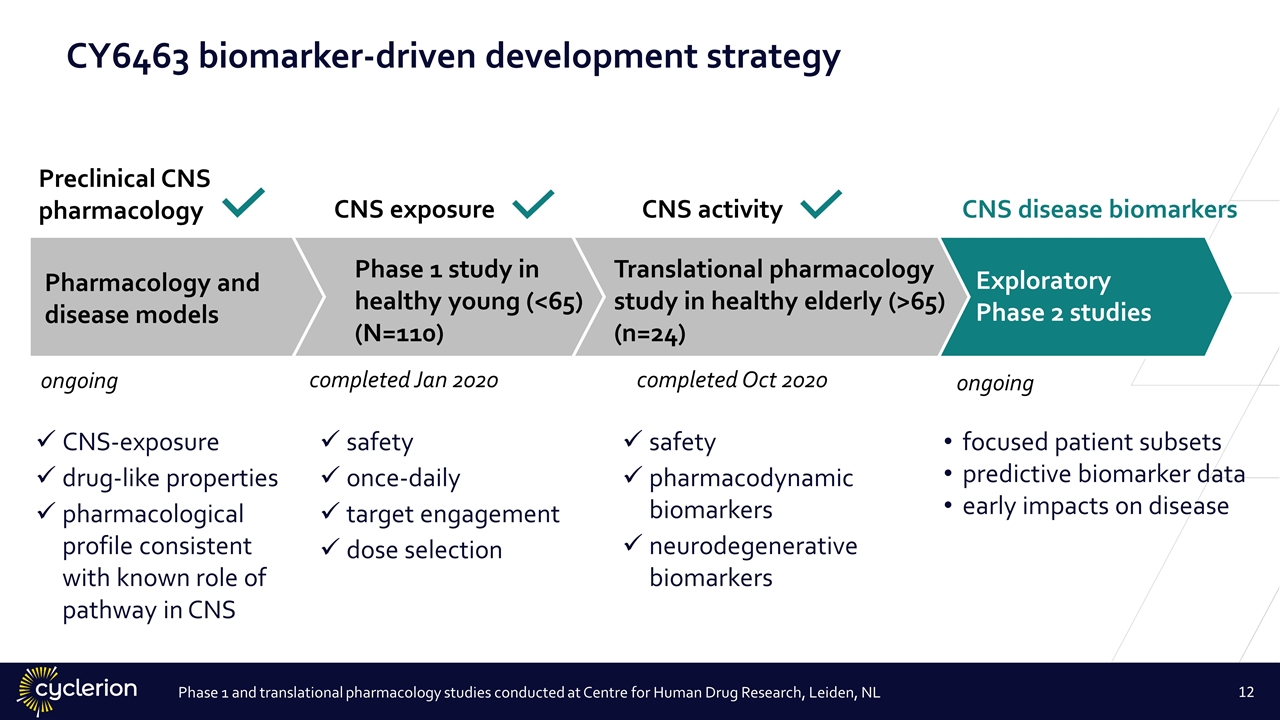
Translational pharmacology study in healthy elderly (>65) (n=24) Exploratory Phase 2 studies CNS exposure CNS activity CNS disease biomarkers Phase 1 and translational pharmacology studies conducted at Centre for Human Drug Research, Leiden, NL CY6463 biomarker-driven development strategy completed Jan 2020 safety once-daily target engagement dose selection completed Oct 2020 safety pharmacodynamic biomarkers neurodegenerative biomarkers focused patient subsets predictive biomarker data early impacts on disease Phase 1 study in healthy young (<65) (N=110) Pharmacology and disease models CNS-exposure drug-like properties pharmacological profile consistent with known role of pathway in CNS Preclinical CNS pharmacology ongoing ongoing
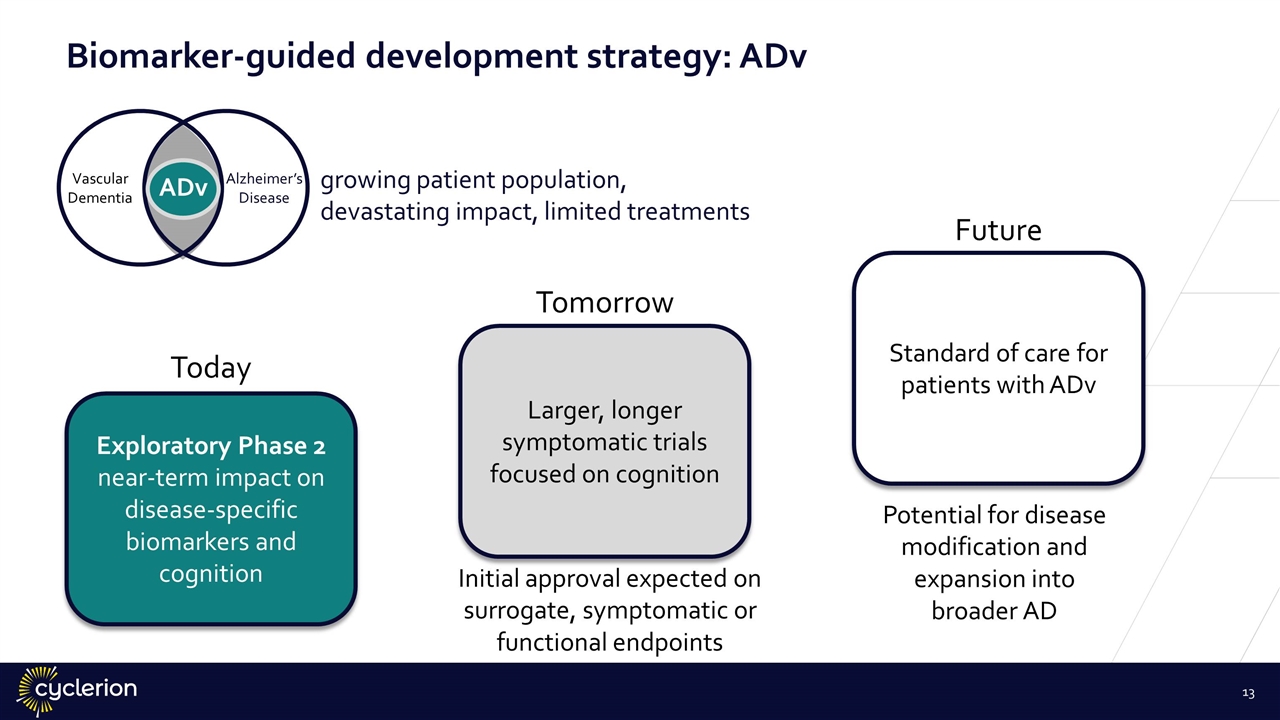
Biomarker-guided development strategy: ADv Exploratory Phase 2 near-term impact on disease-specific biomarkers and cognition Larger, longer symptomatic trials focused on cognition Standard of care for patients with ADv Today Tomorrow Future Potential for disease modification and expansion into broader AD growing patient population, devastating impact, limited treatments Alzheimer’s Disease Vascular Dementia ADv Initial approval expected on surrogate, symptomatic or functional endpoints
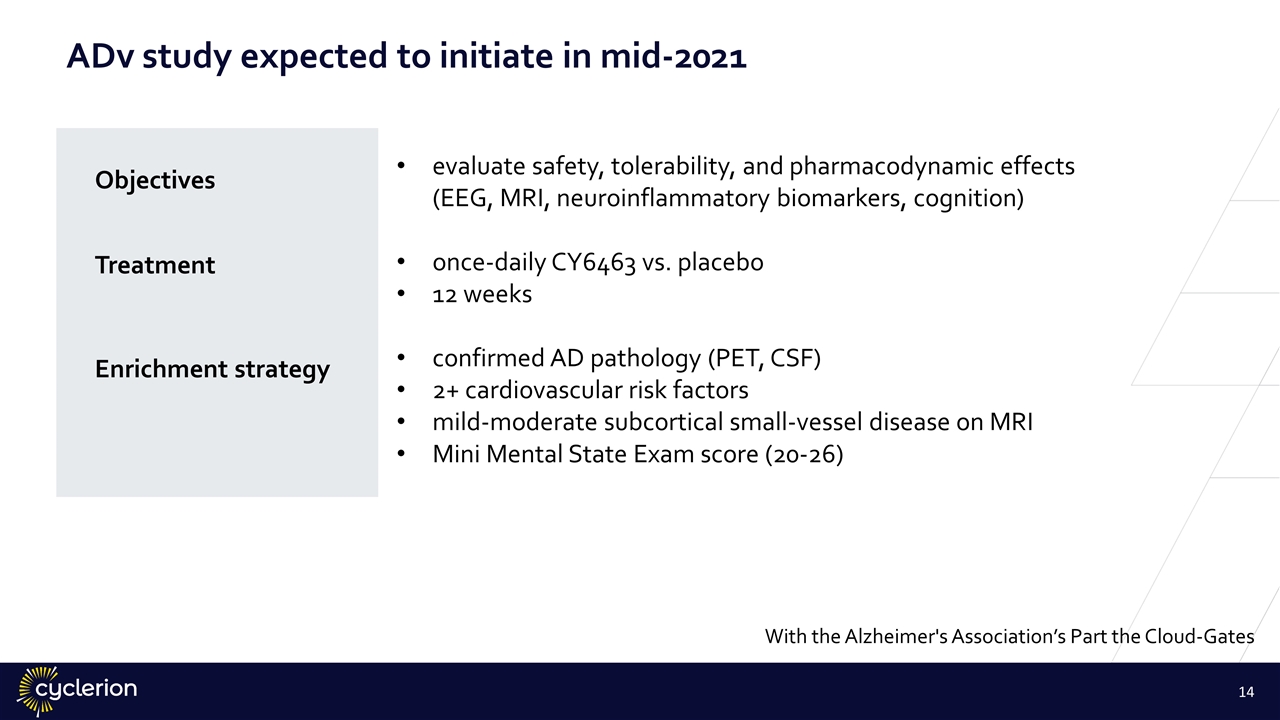
ADv study expected to initiate in mid-2021 evaluate safety, tolerability, and pharmacodynamic effects (EEG, MRI, neuroinflammatory biomarkers, cognition) once-daily CY6463 vs. placebo 12 weeks confirmed AD pathology (PET, CSF) 2+ cardiovascular risk factors mild-moderate subcortical small-vessel disease on MRI Mini Mental State Exam score (20-26) With the Alzheimer's Association’s Part the Cloud-Gates Objectives Treatment Enrichment strategy
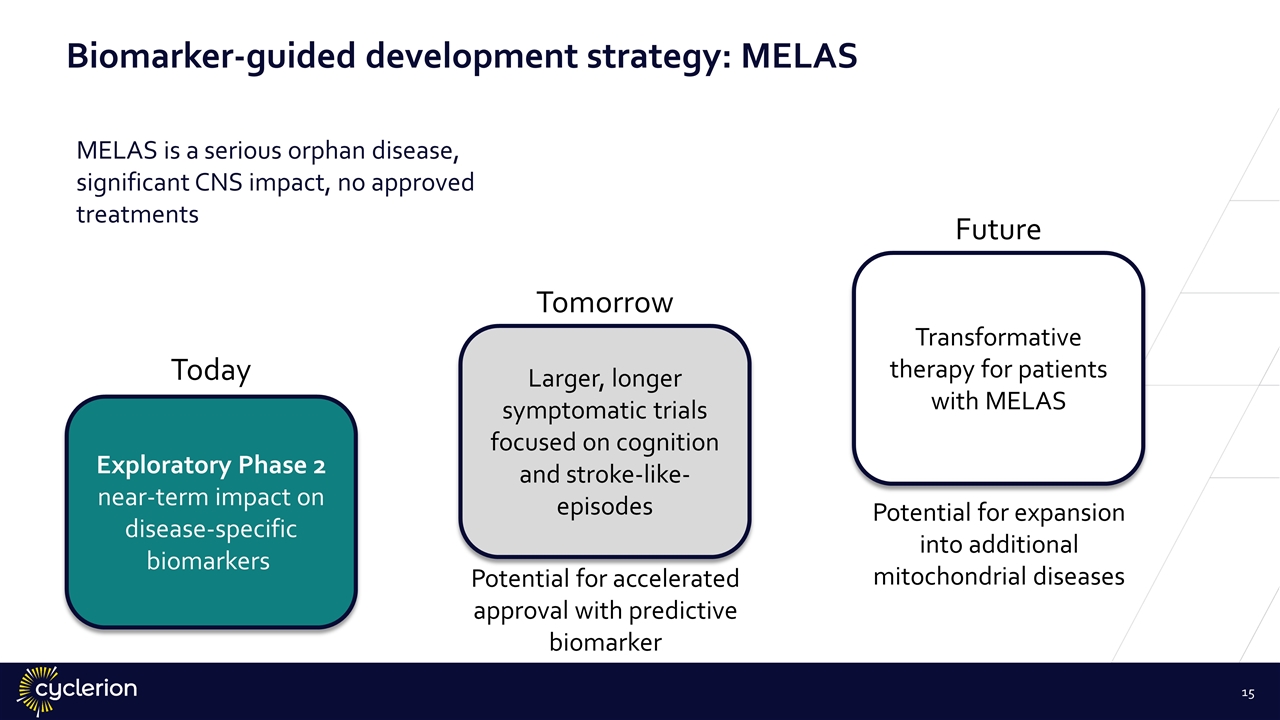
Biomarker-guided development strategy: MELAS Exploratory Phase 2 near-term impact on disease-specific biomarkers Larger, longer symptomatic trials focused on cognition and stroke-like-episodes Transformative therapy for patients with MELAS Today Tomorrow Future Potential for expansion into additional mitochondrial diseases MELAS is a serious orphan disease, significant CNS impact, no approved treatments Potential for accelerated approval with predictive biomarker
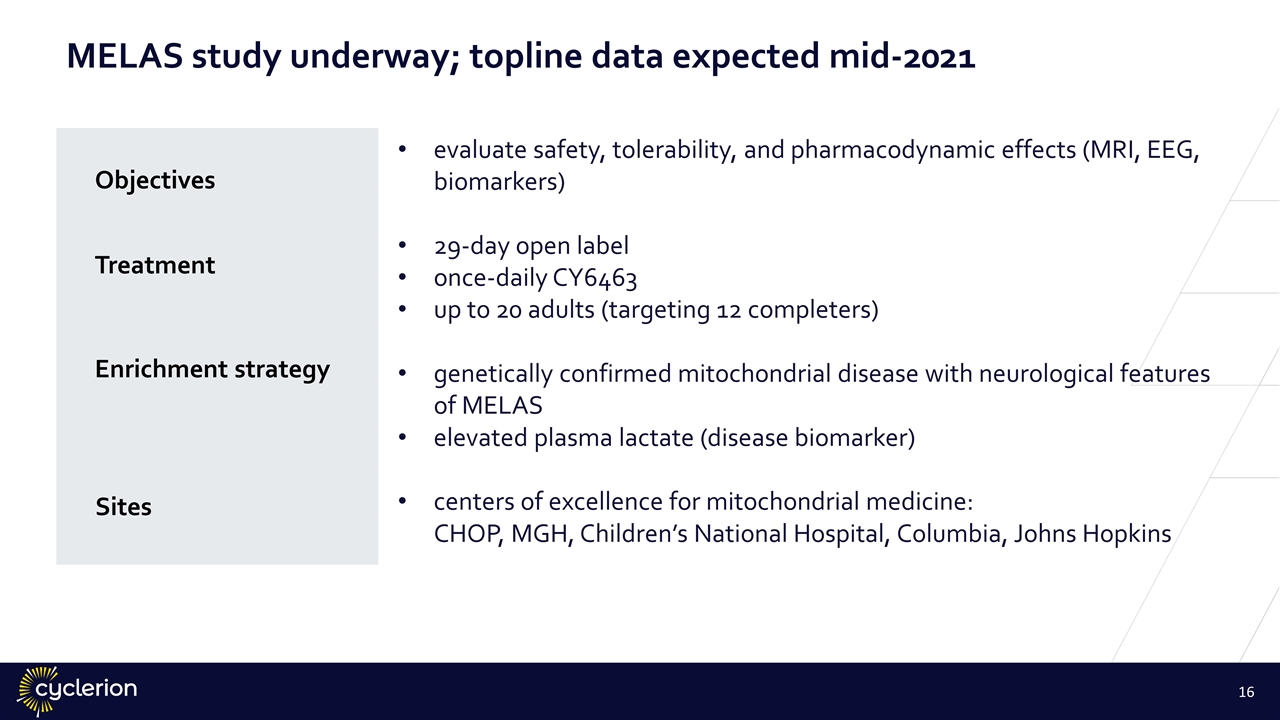
MELAS study underway; topline data expected mid-2021 evaluate safety, tolerability, and pharmacodynamic effects (MRI, EEG, biomarkers) 29-day open label once-daily CY6463 up to 20 adults (targeting 12 completers) genetically confirmed mitochondrial disease with neurological features of MELAS elevated plasma lactate (disease biomarker) centers of excellence for mitochondrial medicine: CHOP, MGH, Children’s National Hospital, Columbia, Johns Hopkins Objectives Treatment Enrichment strategy Sites
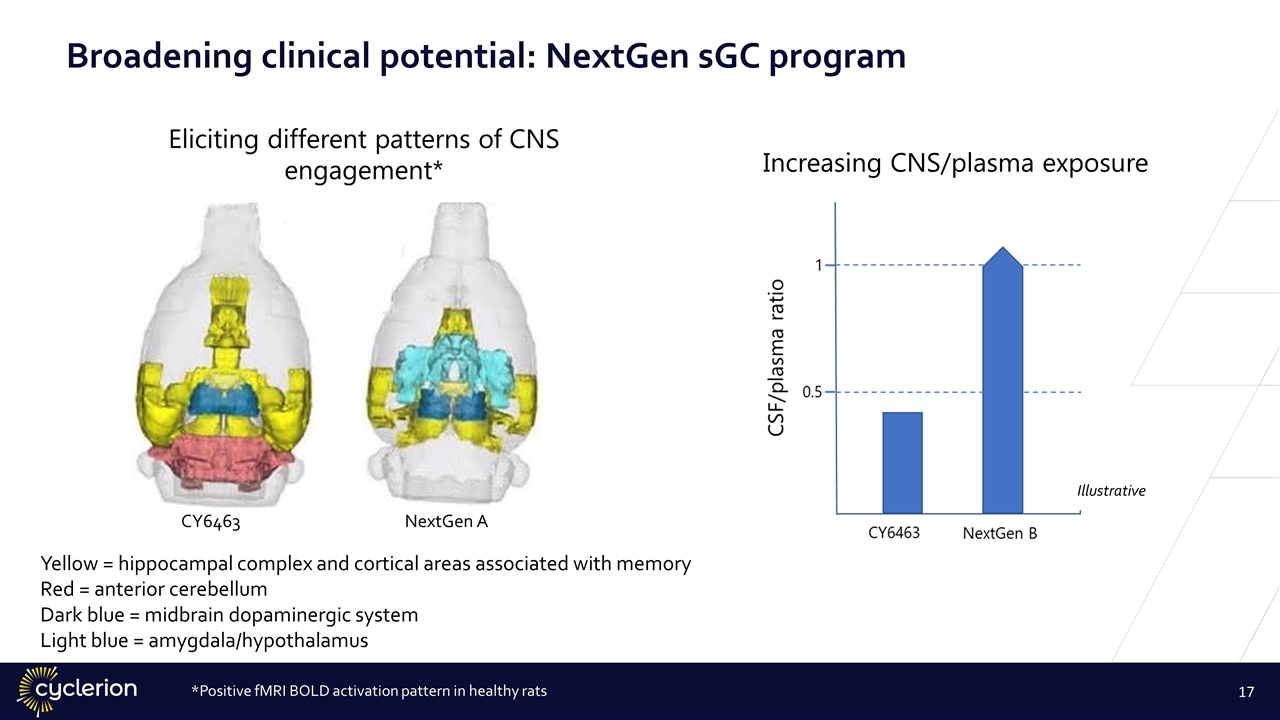
Eliciting different patterns of CNS engagement* Broadening clinical potential: NextGen sGC program *Positive fMRI BOLD activation pattern in healthy rats Increasing CNS/plasma exposure Yellow = hippocampal complex and cortical areas associated with memory Red = anterior cerebellum Dark blue = midbrain dopaminergic system Light blue = amygdala/hypothalamus Illustrative CY6463 NextGen A
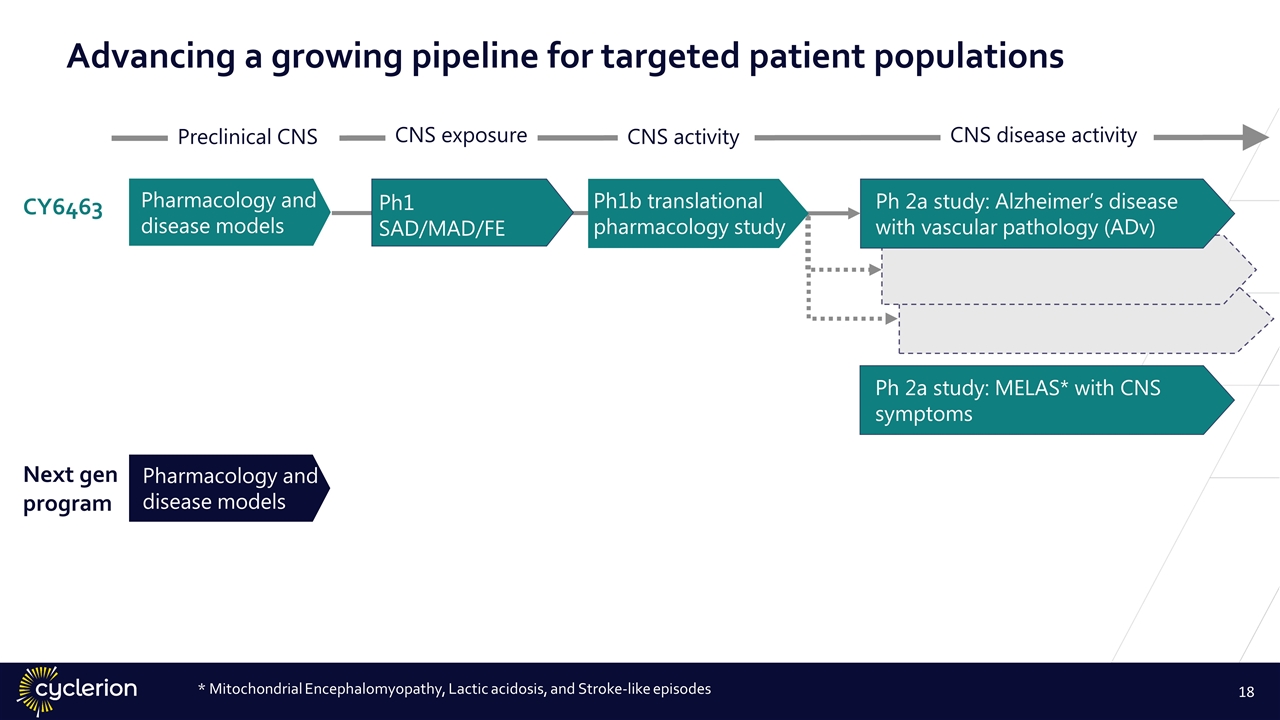
* Mitochondrial Encephalomyopathy, Lactic acidosis, and Stroke-like episodes Ph 2a study: Alzheimer’s disease with vascular pathology (ADv) Ph 2a study: MELAS* with CNS symptoms CNS exposure CNS activity CNS disease activity Ph1 SAD/MAD/FE Ph1b translational pharmacology study Advancing a growing pipeline for targeted patient populations Preclinical CNS Pharmacology and disease models Pharmacology and disease models CY6463 Next gen program
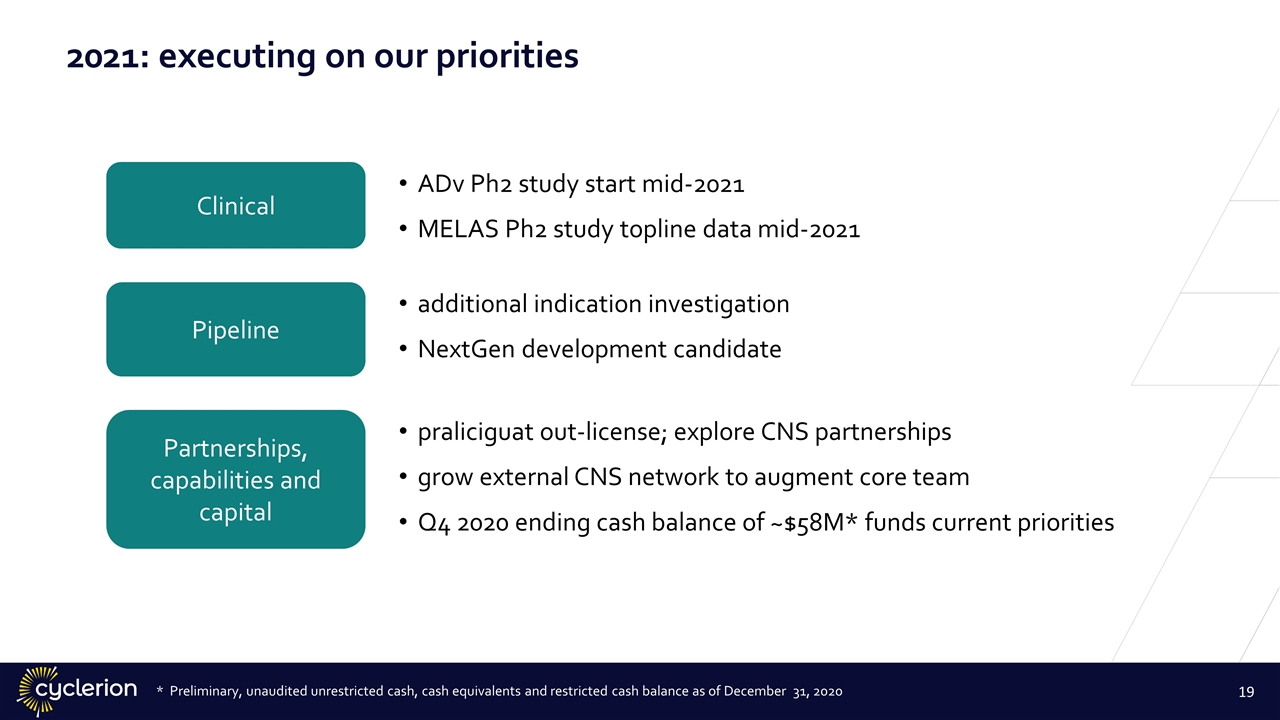
2021: executing on our priorities * Preliminary, unaudited unrestricted cash, cash equivalents and restricted cash balance as of December 31, 2020 ADv Ph2 study start mid-2021 MELAS Ph2 study topline data mid-2021 additional indication investigation NextGen development candidate praliciguat out-license; explore CNS partnerships grow external CNS network to augment core team Q4 2020 ending cash balance of ~$58M* funds current priorities Clinical Pipeline Partnerships, capabilities and capital
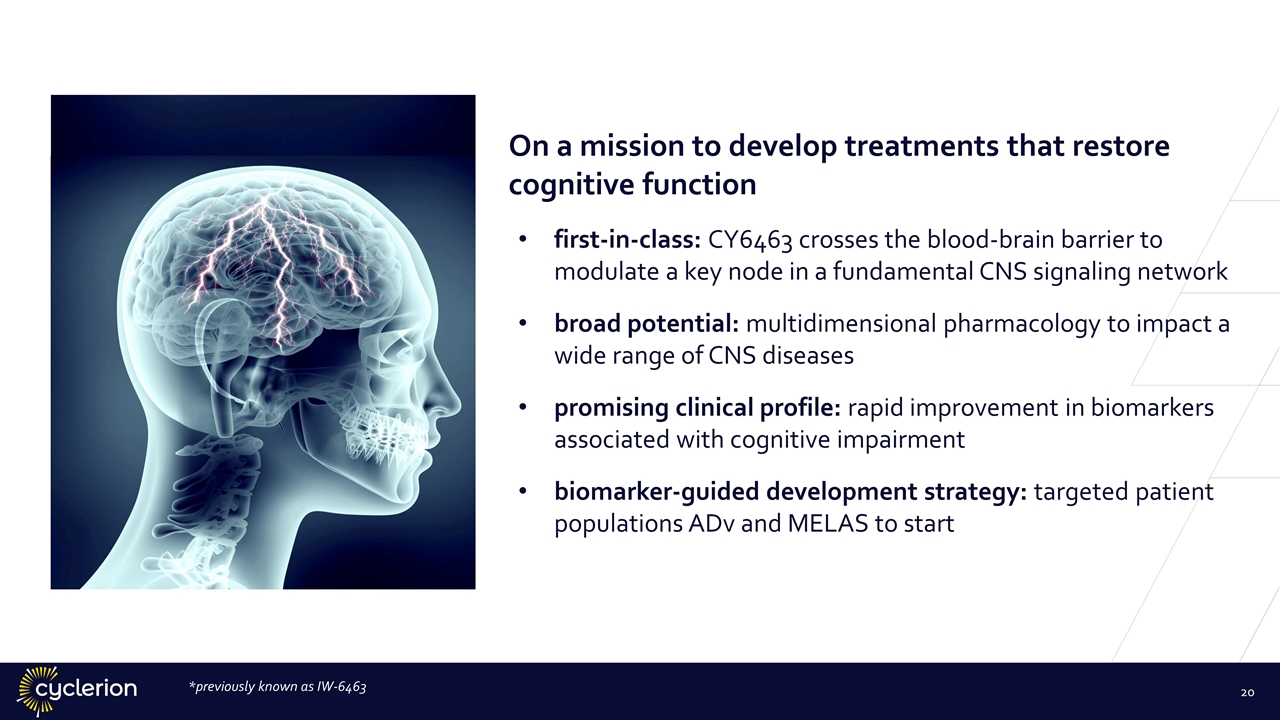
On a mission to develop treatments that restore cognitive function first-in-class: CY6463 crosses the blood-brain barrier to modulate a key node in a fundamental CNS signaling network broad potential: multidimensional pharmacology to impact a wide range of CNS diseases promising clinical profile: rapid improvement in biomarkers associated with cognitive impairment biomarker-guided development strategy: targeted patient populations ADv and MELAS to start *previously known as IW-6463

Appendix
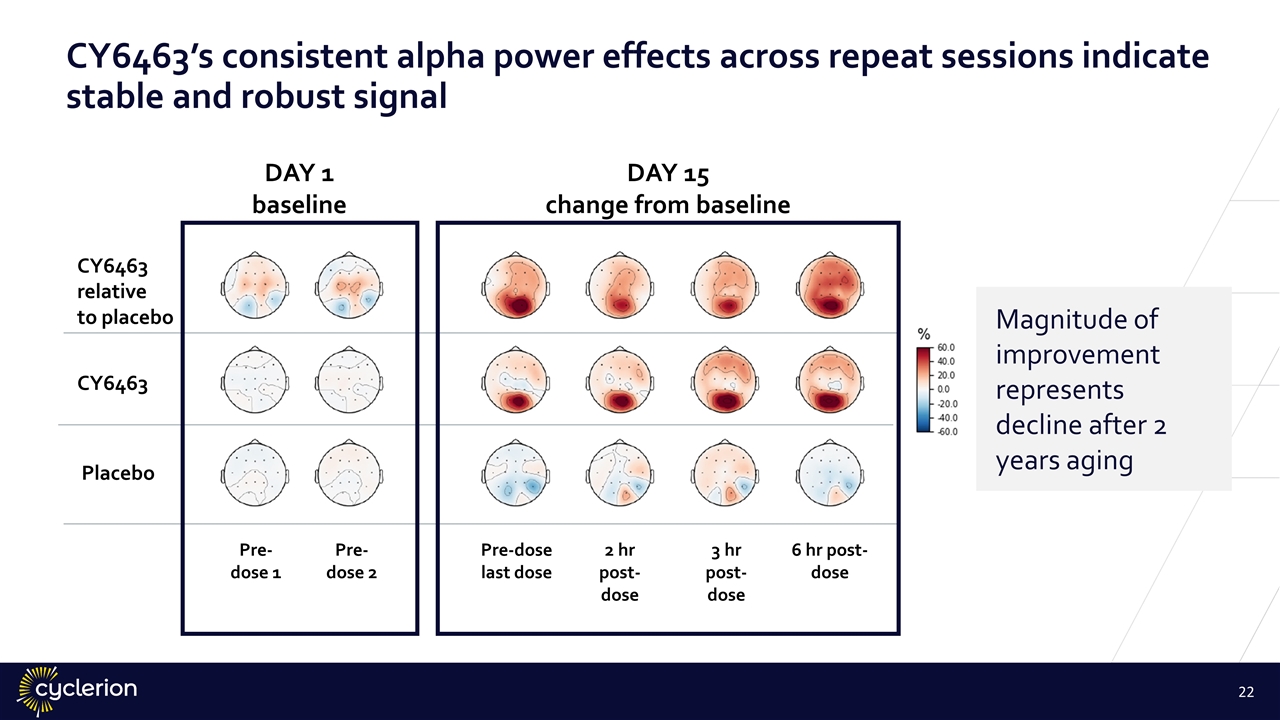
DAY 1 baseline DAY 15 change from baseline Magnitude of improvement represents decline after 2 years aging CY6463’s consistent alpha power effects across repeat sessions indicate stable and robust signal CY6463 relative to placebo CY6463 Placebo Pre- dose 1 Pre- dose 2 Pre-dose last dose 2 hr post-dose 3 hr post-dose 6 hr post-dose
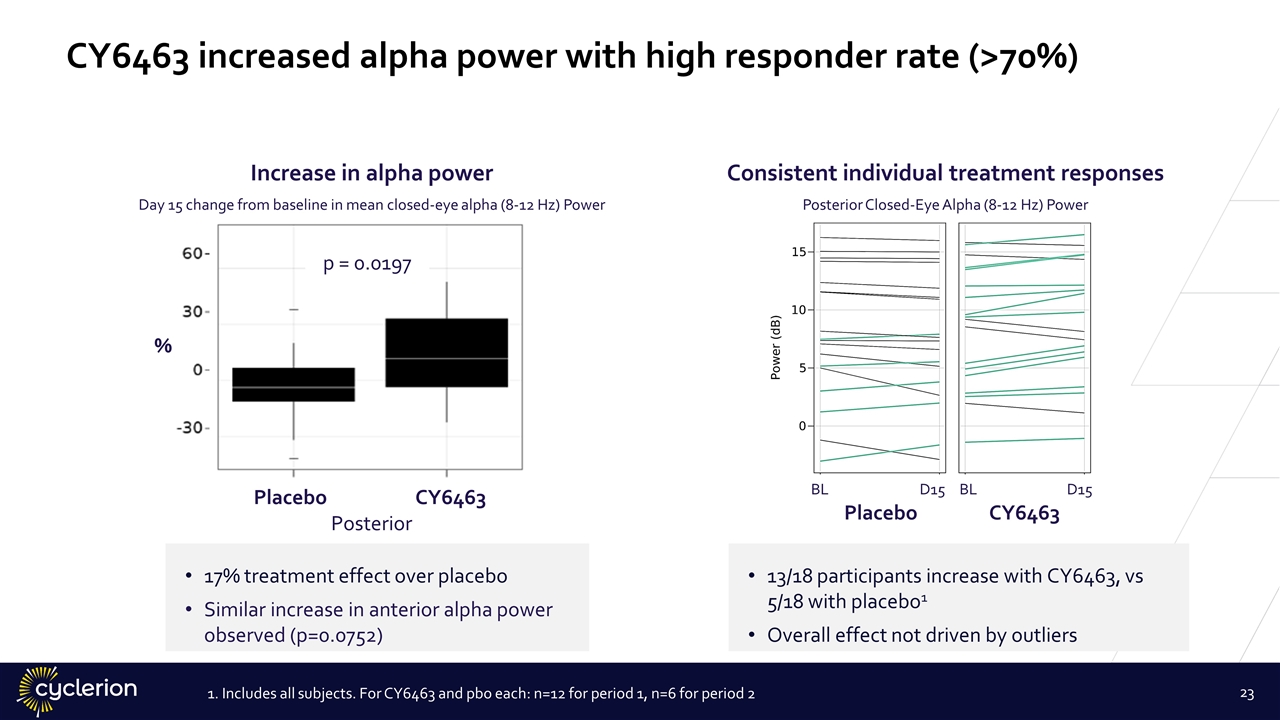
1. Includes all subjects. For CY6463 and pbo each: n=12 for period 1, n=6 for period 2 CY6463 increased alpha power with high responder rate (>70%) Consistent individual treatment responses Posterior Closed-Eye Alpha (8-12 Hz) Power 17% treatment effect over placebo Similar increase in anterior alpha power observed (p=0.0752) 13/18 participants increase with CY6463, vs 5/18 with placebo1 Overall effect not driven by outliers Placebo CY6463 60 30 0 -30 Placebo CY6463 % Placebo CY6463 Posterior p = 0.0197 Increase in alpha power Day 15 change from baseline in mean closed-eye alpha (8-12 Hz) Power BL BL D15 D15
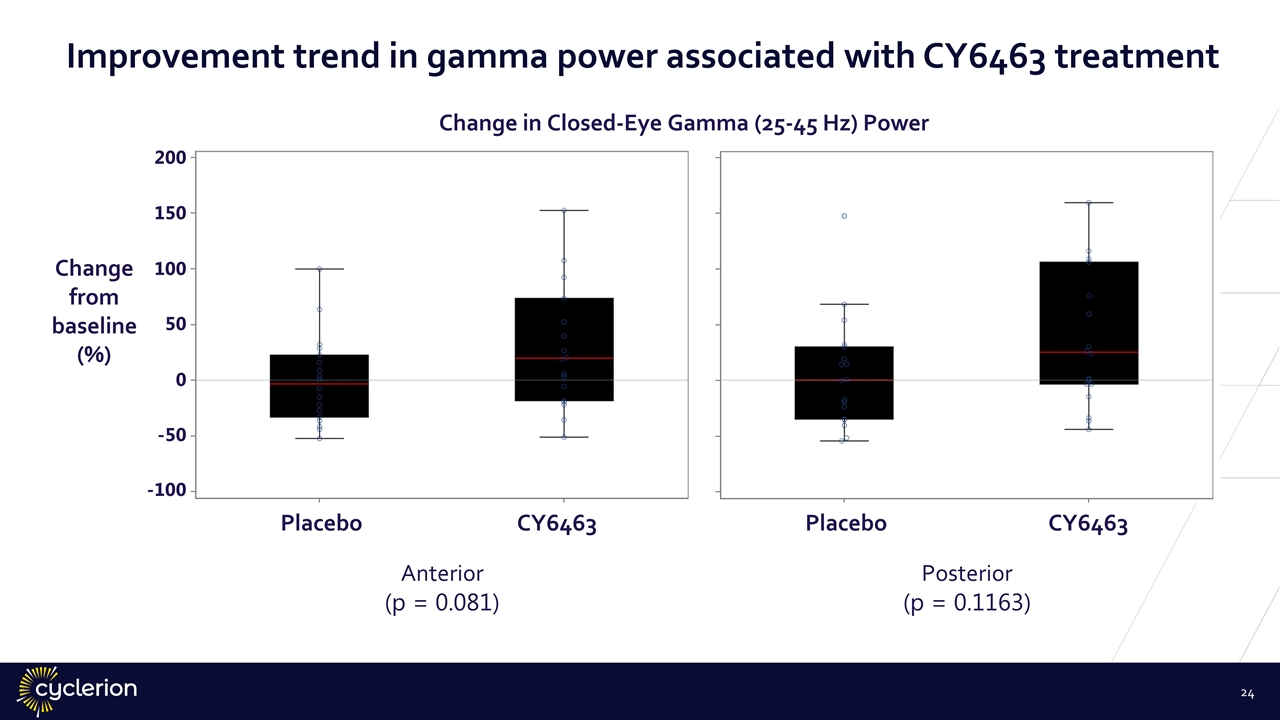
Improvement trend in gamma power associated with CY6463 treatment Placebo CY6463 Placebo CY6463 200 150 100 50 0 -50 -100 Anterior (p = 0.081) Posterior (p = 0.1163) Change from baseline (%) Change in Closed-Eye Gamma (25-45 Hz) Power
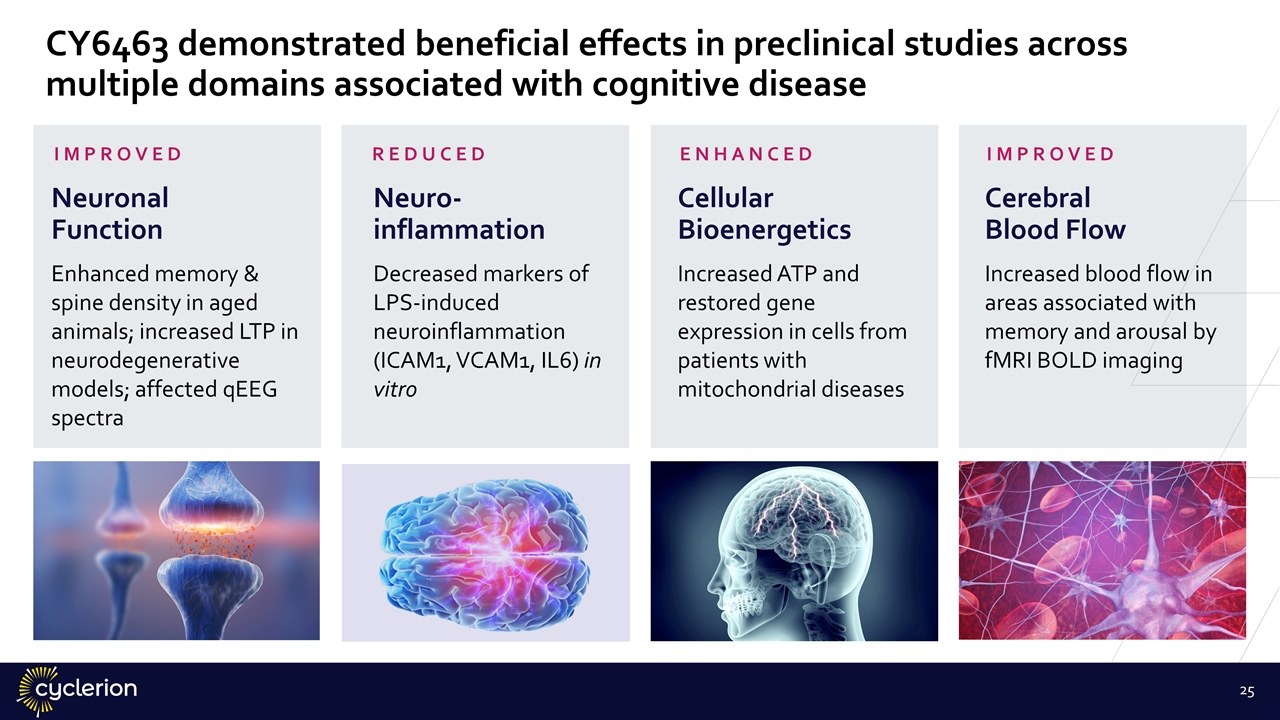
CY6463 demonstrated beneficial effects in preclinical studies across multiple domains associated with cognitive disease Cerebral Blood Flow Increased blood flow in areas associated with memory and arousal by fMRI BOLD imaging IMPROVED Cellular Bioenergetics Increased ATP and restored gene expression in cells from patients with mitochondrial diseases ENHANCED Neuronal Function Enhanced memory & spine density in aged animals; increased LTP in neurodegenerative models; affected qEEG spectra IMPROVED Neuro- inflammation Decreased markers of LPS-induced neuroinflammation (ICAM1, VCAM1, IL6) in vitro REDUCED
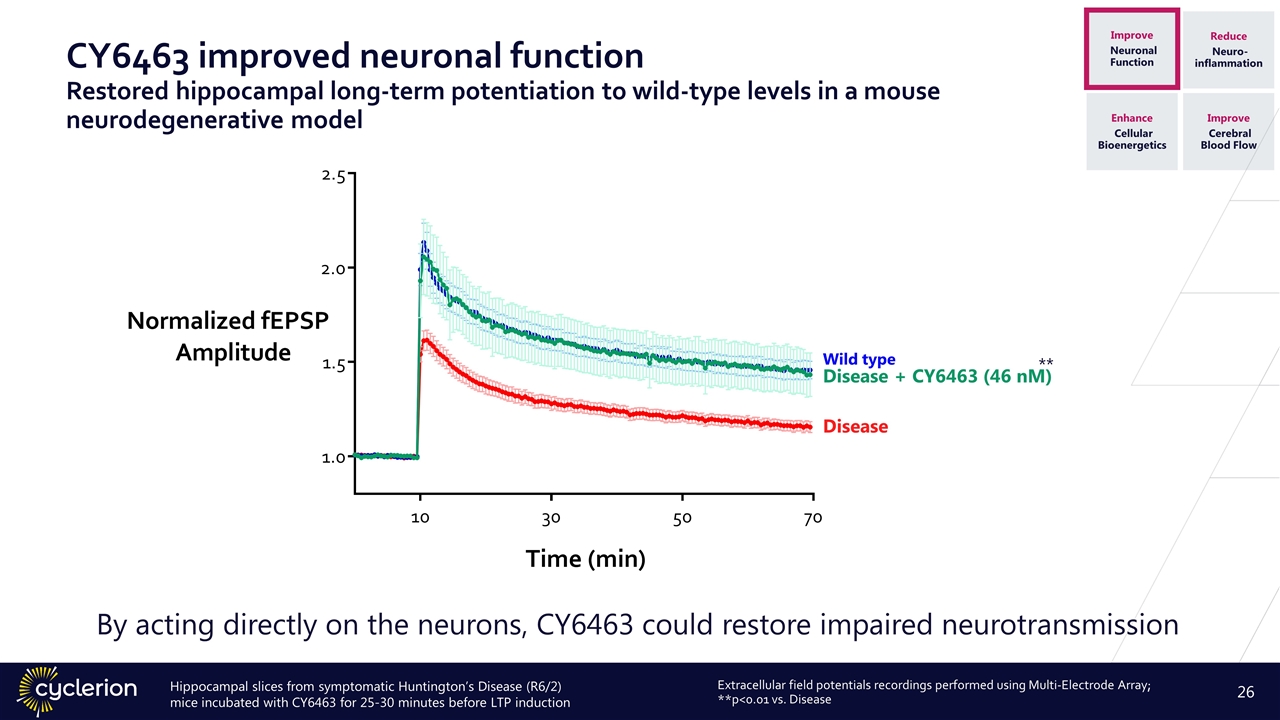
CY6463 improved neuronal function Restored hippocampal long-term potentiation to wild-type levels in a mouse neurodegenerative model Wild type Disease Disease + CY6463 (46 nM) Hippocampal slices from symptomatic Huntington’s Disease (R6/2) mice incubated with CY6463 for 25-30 minutes before LTP induction ** Extracellular field potentials recordings performed using Multi-Electrode Array; **p<0.01 vs. Disease By acting directly on the neurons, CY6463 could restore impaired neurotransmission Improve Cerebral Blood Flow Enhance Cellular Bioenergetics Reduce Neuro- inflammation Improve Neuronal Function
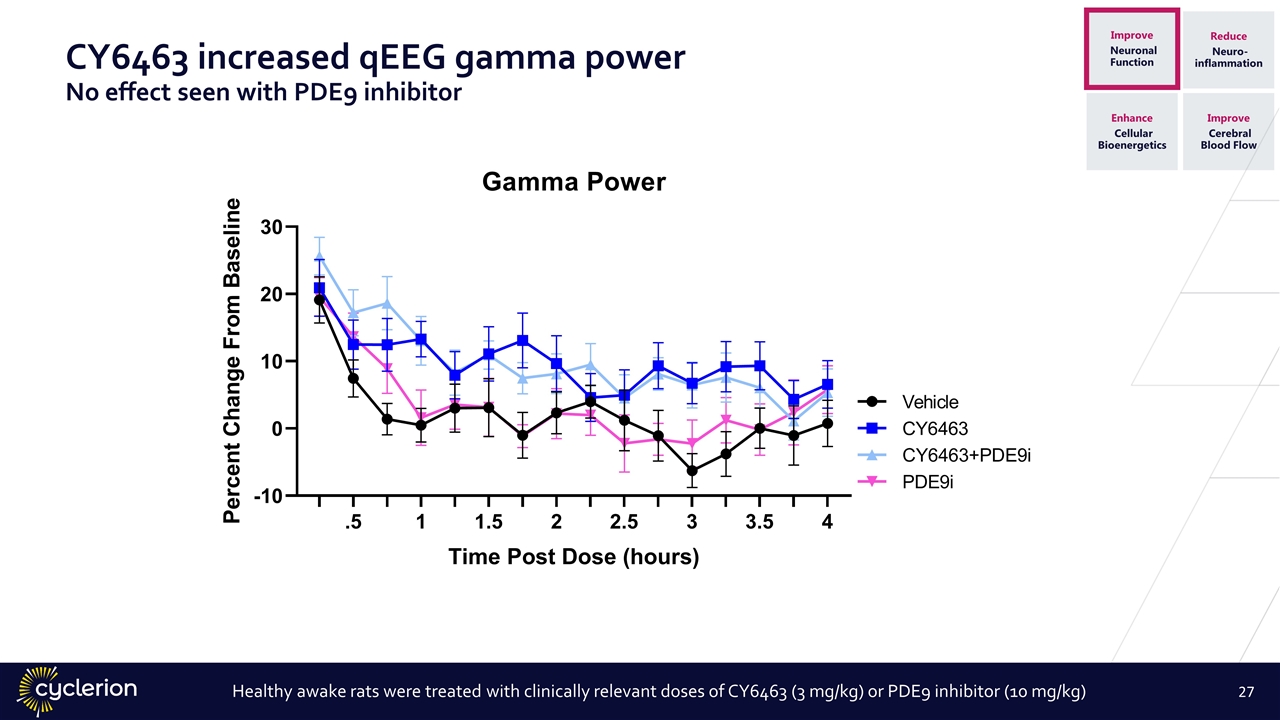
CY6463 increased qEEG gamma power No effect seen with PDE9 inhibitor Healthy awake rats were treated with clinically relevant doses of CY6463 (3 mg/kg) or PDE9 inhibitor (10 mg/kg) Improve Cerebral Blood Flow Enhance Cellular Bioenergetics Reduce Neuro- inflammation Improve Neuronal Function
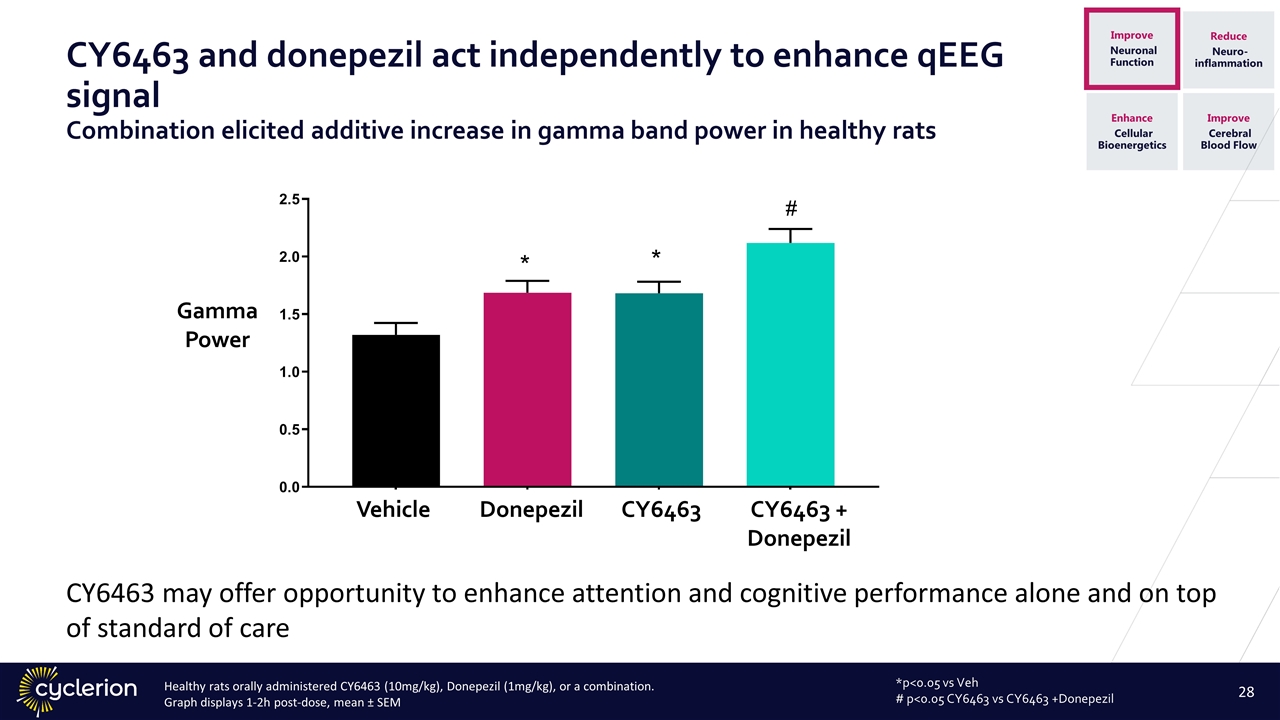
CY6463 and donepezil act independently to enhance qEEG signal Combination elicited additive increase in gamma band power in healthy rats CY6463 may offer opportunity to enhance attention and cognitive performance alone and on top of standard of care *p<0.05 vs Veh # p<0.05 CY6463 vs CY6463 +Donepezil Healthy rats orally administered CY6463 (10mg/kg), Donepezil (1mg/kg), or a combination. Graph displays 1-2h post-dose, mean ± SEM Gamma Power Improve Cerebral Blood Flow Enhance Cellular Bioenergetics Reduce Neuro- inflammation Improve Neuronal Function Vehicle Donepezil CY6463 CY6463 + Donepezil
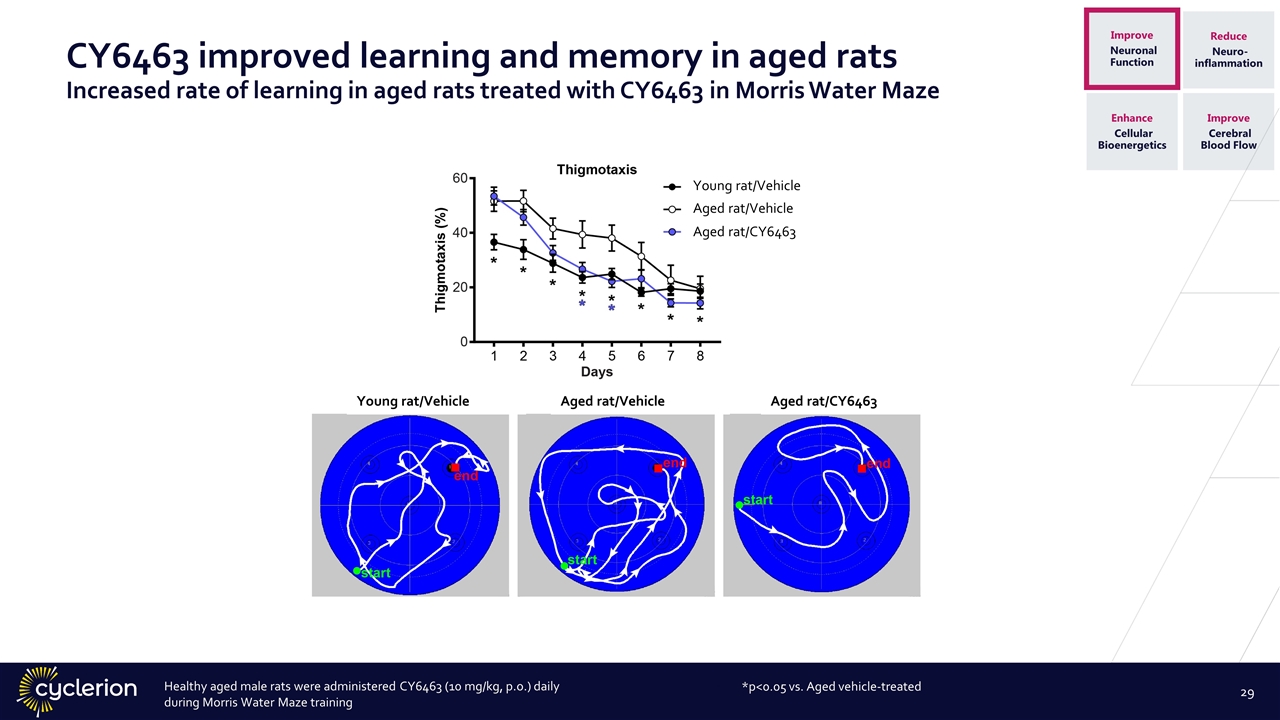
CY6463 improved learning and memory in aged rats Increased rate of learning in aged rats treated with CY6463 in Morris Water Maze Healthy aged male rats were administered CY6463 (10 mg/kg, p.o.) daily during Morris Water Maze training *p<0.05 vs. Aged vehicle-treated Improve Cerebral Blood Flow Enhance Cellular Bioenergetics Reduce Neuro- inflammation Improve Neuronal Function Aged rat/CY6463 Aged rat/Vehicle Young rat/Vehicle Young rat/Vehicle Aged rat/Vehicle Aged rat/CY6463

CY6463 improved cognitive function in pharmacologically impaired rats **p<0.01 vs. VEH + MK801 rats ***p<0.001 vs. VEH + MK801 rats Male rats administered vehicle, galantamine (positive control) or CY6463, followed by MK-801 or vehicle Improve Cerebral Blood Flow Enhance Cellular Bioenergetics Reduce Neuro- inflammation Improve Neuronal Function CY6463 (oral) + MK-801
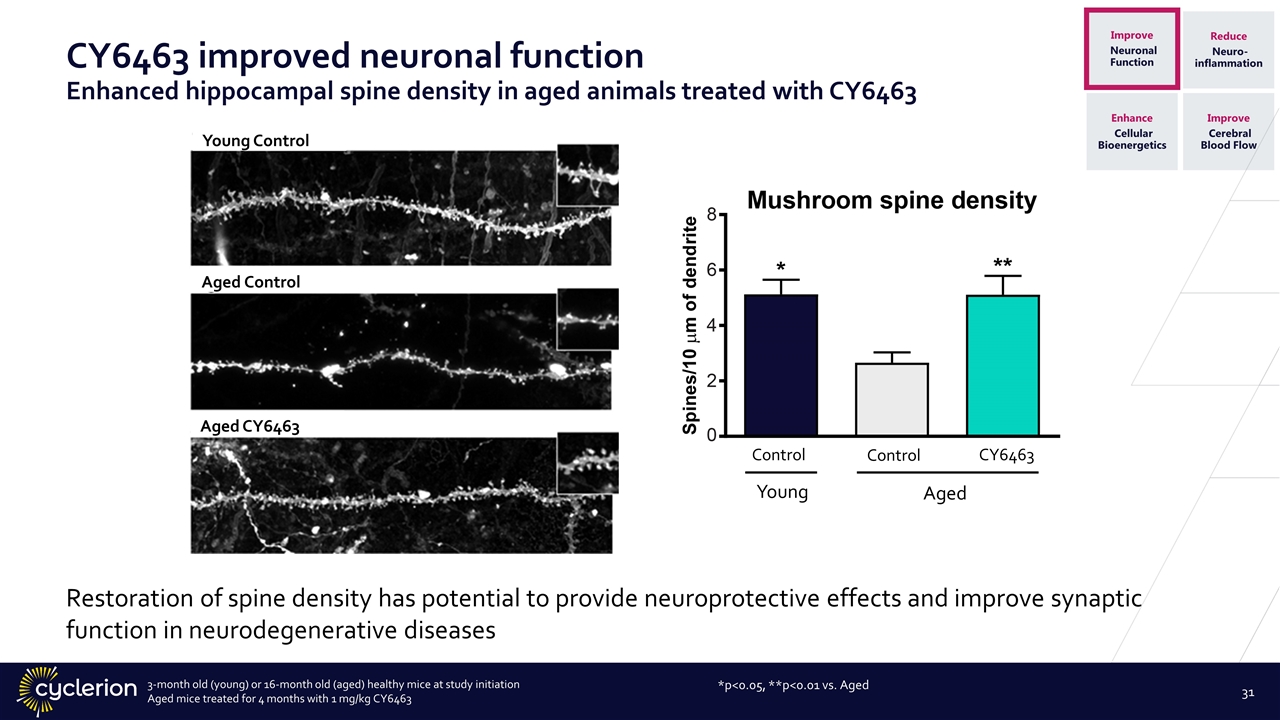
Aged Control CY6463 improved neuronal function Enhanced hippocampal spine density in aged animals treated with CY6463 3-month old (young) or 16-month old (aged) healthy mice at study initiation Aged mice treated for 4 months with 1 mg/kg CY6463 *p<0.05, **p<0.01 vs. Aged Restoration of spine density has potential to provide neuroprotective effects and improve synaptic function in neurodegenerative diseases Improve Cerebral Blood Flow Enhance Cellular Bioenergetics Reduce Neuro- inflammation Improve Neuronal Function CY6463 Control Control Young Aged Young Control Aged Control Aged CY6463
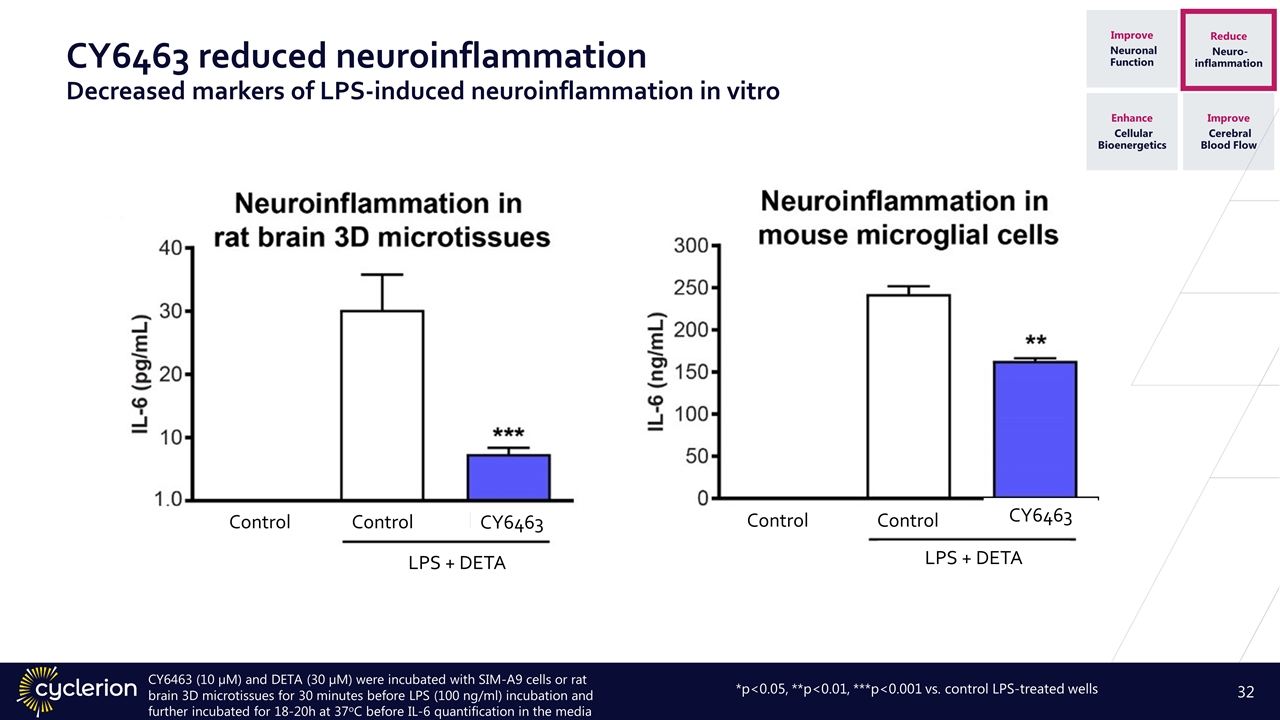
CY6463 reduced neuroinflammation Decreased markers of LPS-induced neuroinflammation in vitro *p<0.05, **p<0.01, ***p<0.001 vs. control LPS-treated wells CY6463 (10 µM) and DETA (30 µM) were incubated with SIM-A9 cells or rat brain 3D microtissues for 30 minutes before LPS (100 ng/ml) incubation and further incubated for 18-20h at 37oC before IL-6 quantification in the media Improve Cerebral Blood Flow Enhance Cellular Bioenergetics Reduce Neuro- inflammation Improve Neuronal Function CY6463 Control Control LPS + DETA CY6463 Control Control LPS + DETA
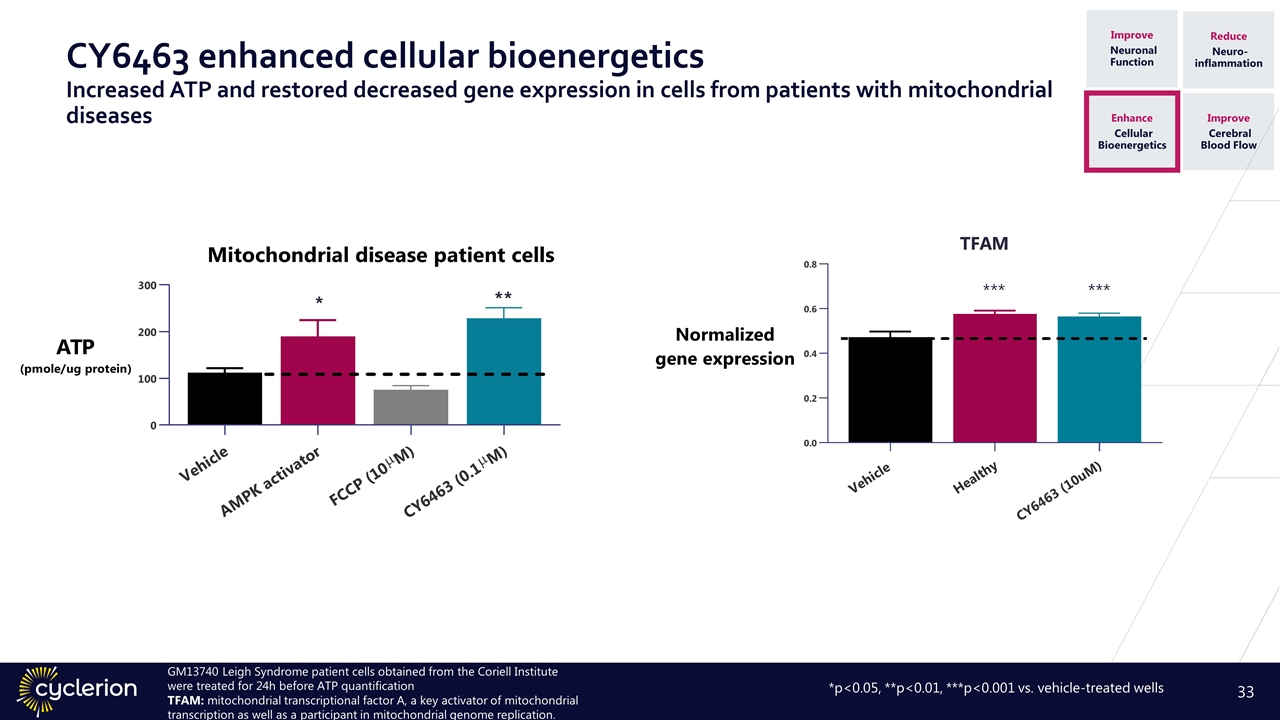
CY6463 enhanced cellular bioenergetics Increased ATP and restored decreased gene expression in cells from patients with mitochondrial diseases *p<0.05, **p<0.01, ***p<0.001 vs. vehicle-treated wells GM13740 Leigh Syndrome patient cells obtained from the Coriell Institute were treated for 24h before ATP quantification TFAM: mitochondrial transcriptional factor A, a key activator of mitochondrial transcription as well as a participant in mitochondrial genome replication. Improve Cerebral Blood Flow Enhance Cellular Bioenergetics Reduce Neuro- inflammation Improve Neuronal Function
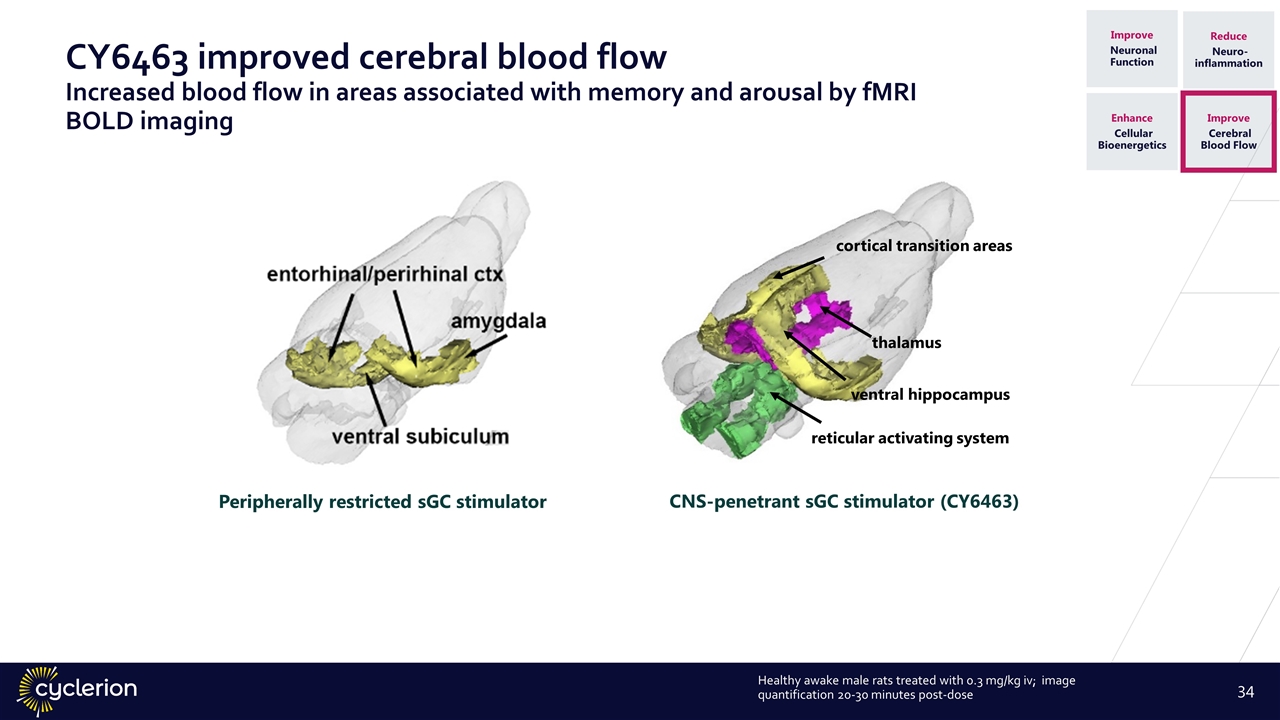
CY6463 improved cerebral blood flow Increased blood flow in areas associated with memory and arousal by fMRI BOLD imaging Healthy awake male rats treated with 0.3 mg/kg iv; image quantification 20-30 minutes post-dose reticular activating system thalamus cortical transition areas ventral hippocampus Peripherally restricted sGC stimulator CNS-penetrant sGC stimulator (CY6463) Improve Cerebral Blood Flow Enhance Cellular Bioenergetics Reduce Neuro- inflammation Improve Neuronal Function
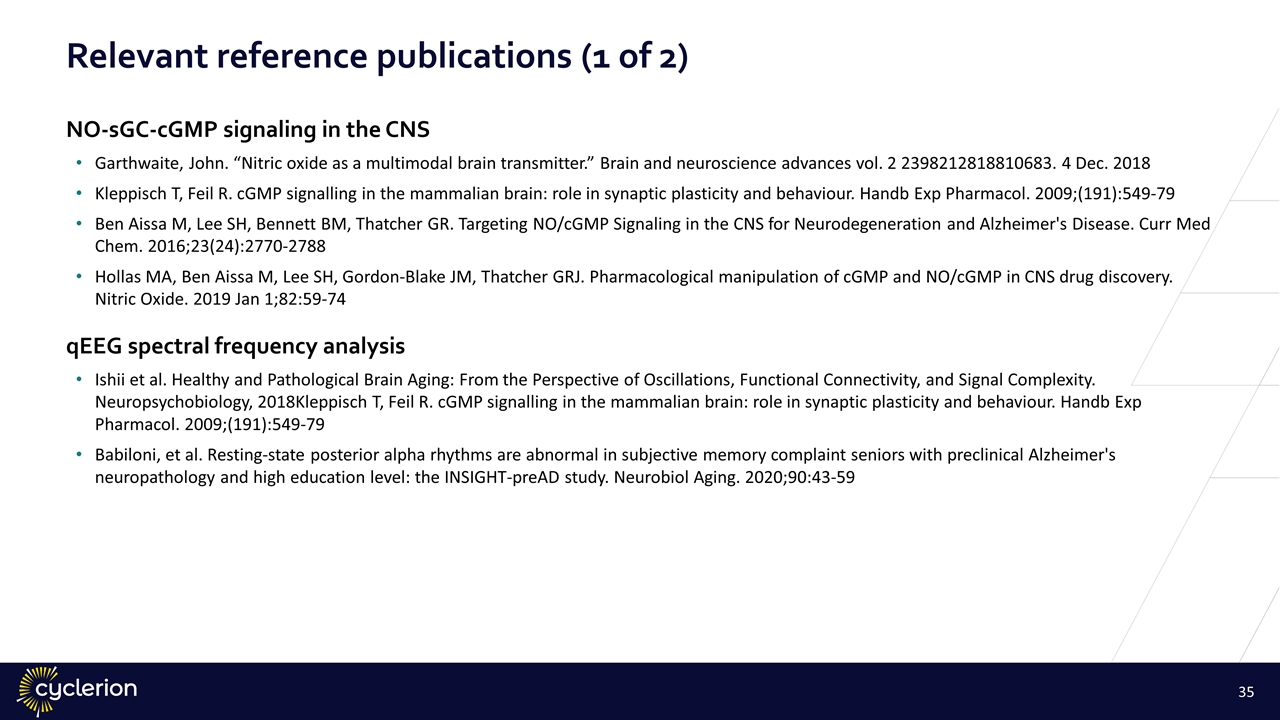
Relevant reference publications (1 of 2) NO-sGC-cGMP signaling in the CNS Garthwaite, John. “Nitric oxide as a multimodal brain transmitter.” Brain and neuroscience advances vol. 2 2398212818810683. 4 Dec. 2018 Kleppisch T, Feil R. cGMP signalling in the mammalian brain: role in synaptic plasticity and behaviour. Handb Exp Pharmacol. 2009;(191):549-79 Ben Aissa M, Lee SH, Bennett BM, Thatcher GR. Targeting NO/cGMP Signaling in the CNS for Neurodegeneration and Alzheimer's Disease. Curr Med Chem. 2016;23(24):2770-2788 Hollas MA, Ben Aissa M, Lee SH, Gordon-Blake JM, Thatcher GRJ. Pharmacological manipulation of cGMP and NO/cGMP in CNS drug discovery. Nitric Oxide. 2019 Jan 1;82:59-74 qEEG spectral frequency analysis Ishii et al. Healthy and Pathological Brain Aging: From the Perspective of Oscillations, Functional Connectivity, and Signal Complexity. Neuropsychobiology, 2018Kleppisch T, Feil R. cGMP signalling in the mammalian brain: role in synaptic plasticity and behaviour. Handb Exp Pharmacol. 2009;(191):549-79 Babiloni, et al. Resting-state posterior alpha rhythms are abnormal in subjective memory complaint seniors with preclinical Alzheimer's neuropathology and high education level: the INSIGHT-preAD study. Neurobiol Aging. 2020;90:43-59
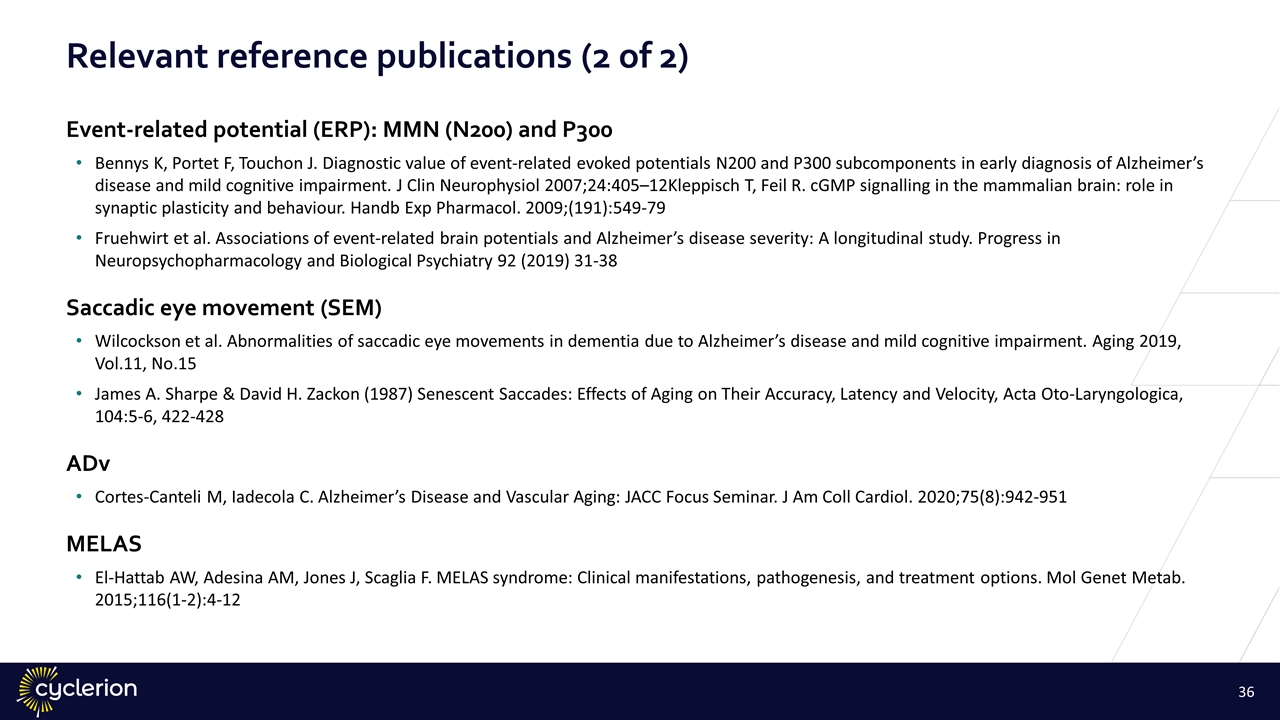
Event-related potential (ERP): MMN (N200) and P300 Bennys K, Portet F, Touchon J. Diagnostic value of event-related evoked potentials N200 and P300 subcomponents in early diagnosis of Alzheimer’s disease and mild cognitive impairment. J Clin Neurophysiol 2007;24:405–12Kleppisch T, Feil R. cGMP signalling in the mammalian brain: role in synaptic plasticity and behaviour. Handb Exp Pharmacol. 2009;(191):549-79 Fruehwirt et al. Associations of event-related brain potentials and Alzheimer’s disease severity: A longitudinal study. Progress in Neuropsychopharmacology and Biological Psychiatry 92 (2019) 31-38 Saccadic eye movement (SEM) Wilcockson et al. Abnormalities of saccadic eye movements in dementia due to Alzheimer’s disease and mild cognitive impairment. Aging 2019, Vol.11, No.15 James A. Sharpe & David H. Zackon (1987) Senescent Saccades: Effects of Aging on Their Accuracy, Latency and Velocity, Acta Oto-Laryngologica, 104:5-6, 422-428 ADv Cortes-Canteli M, Iadecola C. Alzheimer’s Disease and Vascular Aging: JACC Focus Seminar. J Am Coll Cardiol. 2020;75(8):942-951 MELAS El-Hattab AW, Adesina AM, Jones J, Scaglia F. MELAS syndrome: Clinical manifestations, pathogenesis, and treatment options. Mol Genet Metab. 2015;116(1-2):4-12 Relevant reference publications (2 of 2)
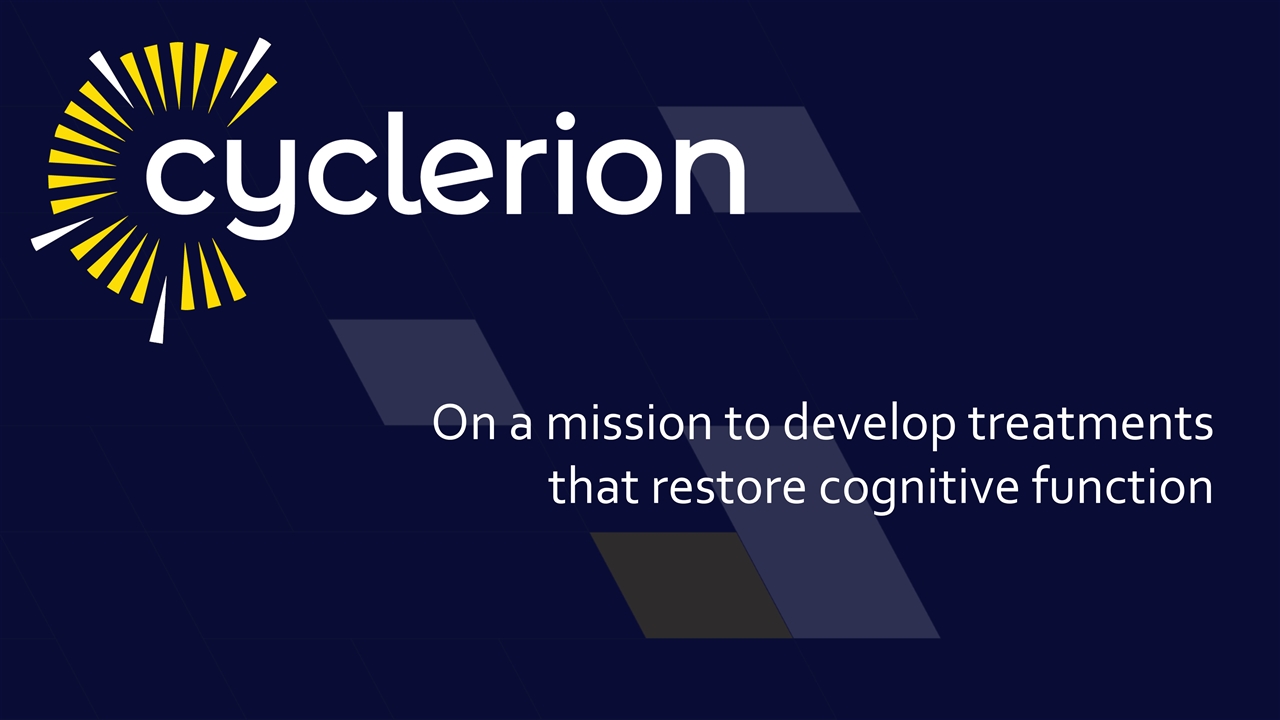
On a mission to develop treatments that restore cognitive function




































